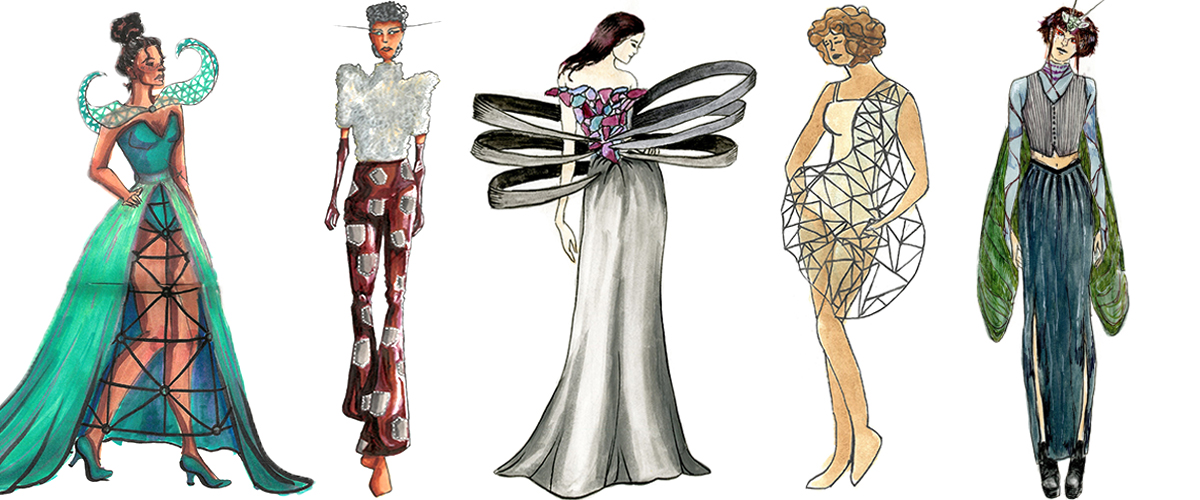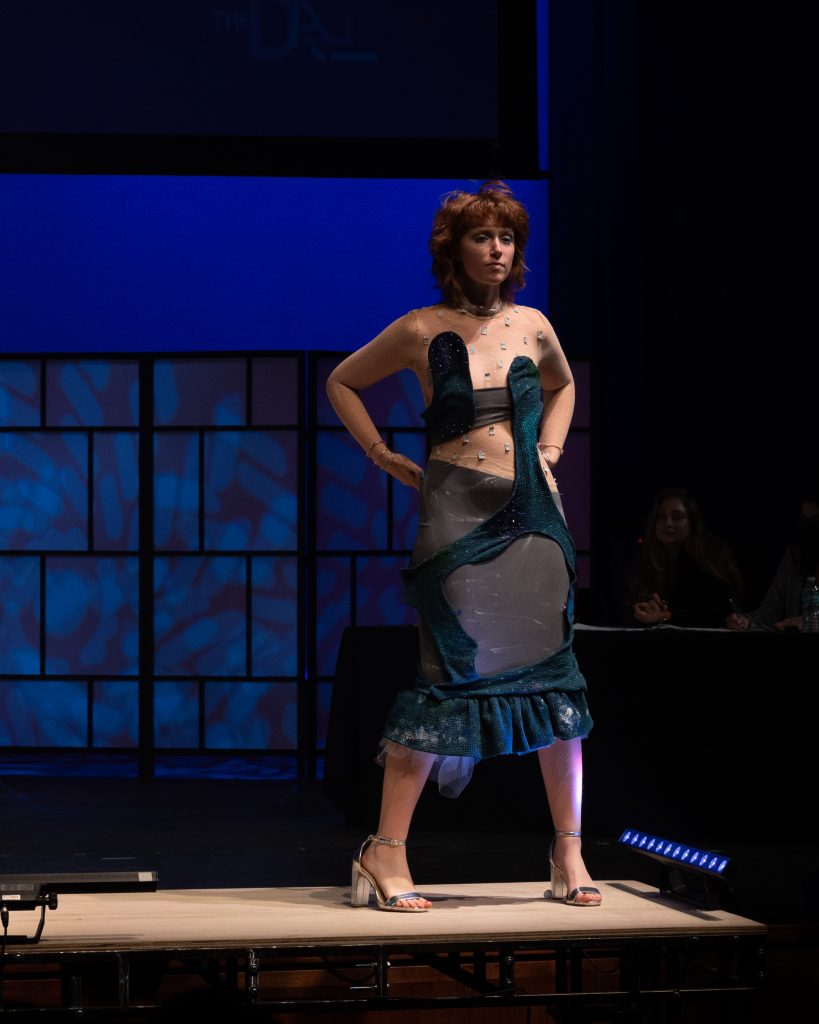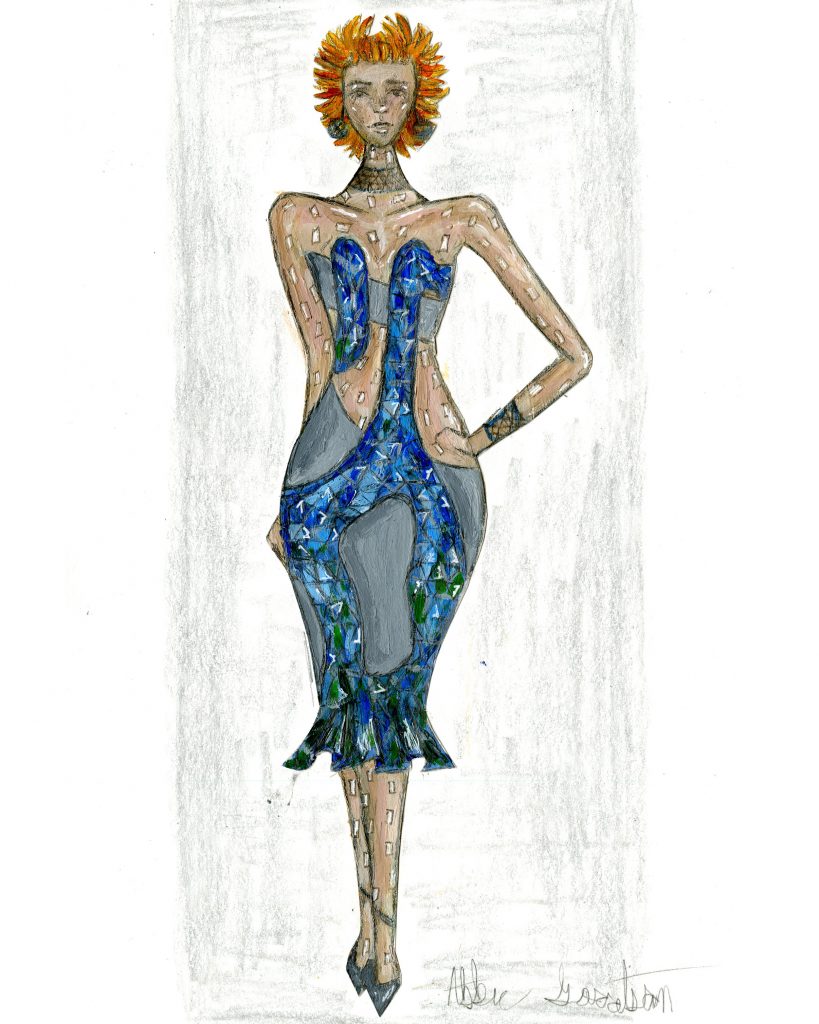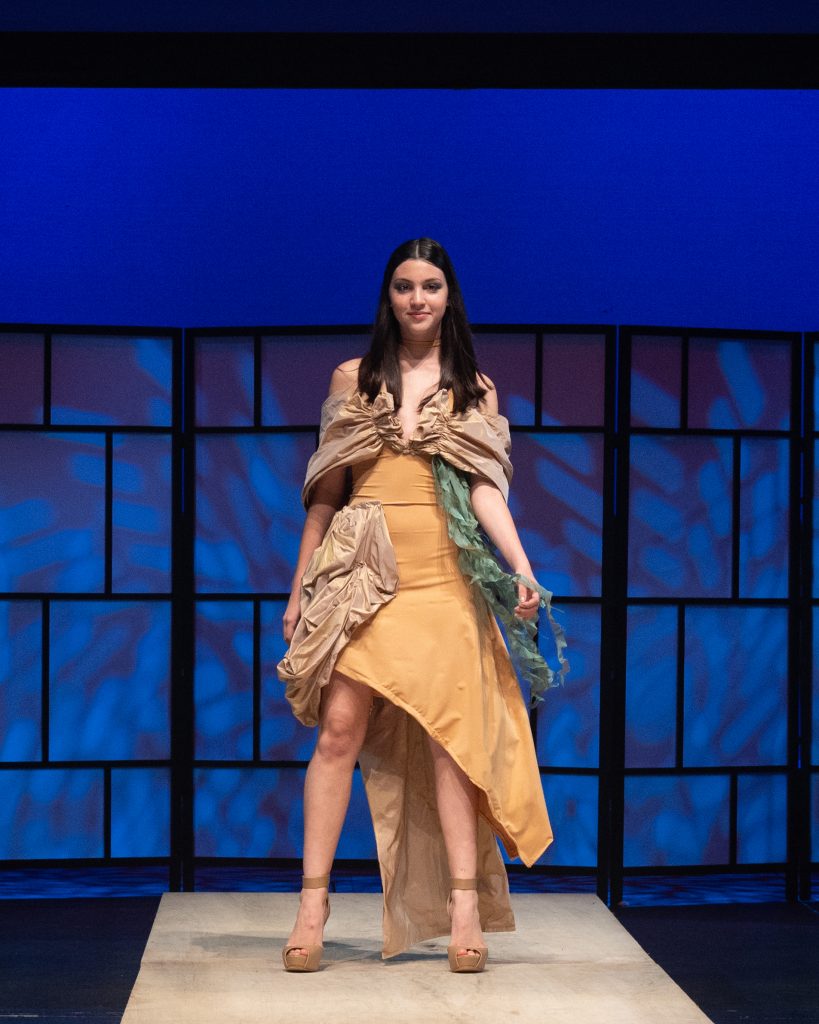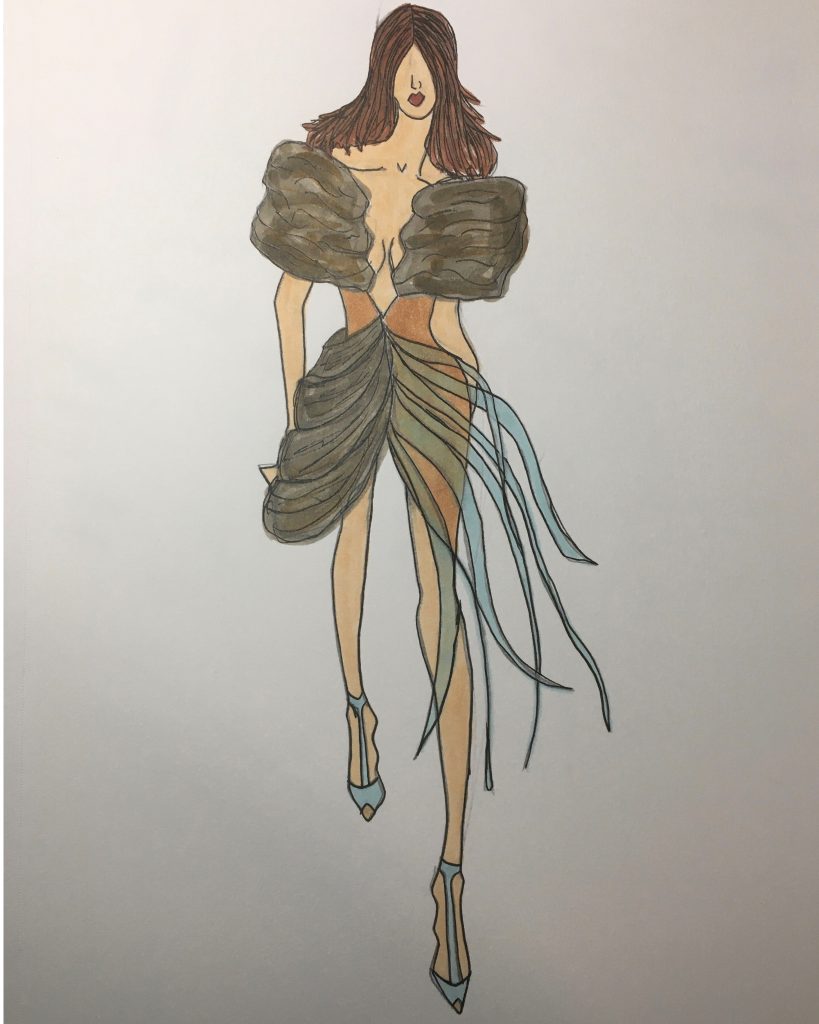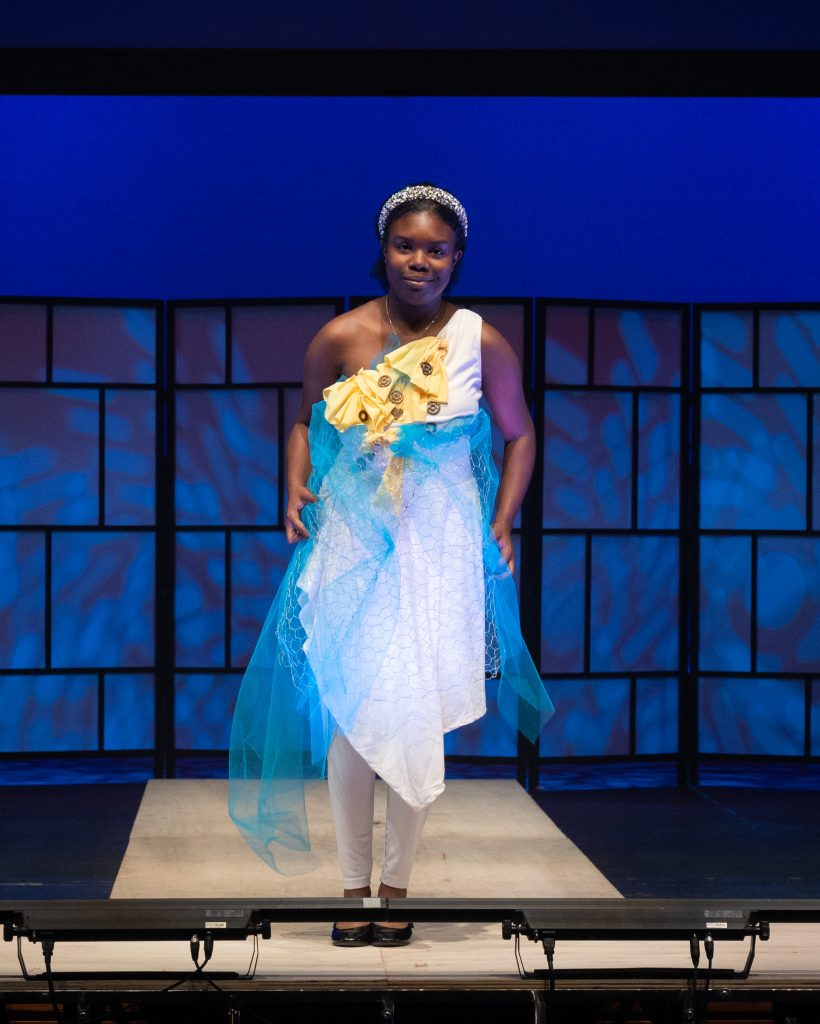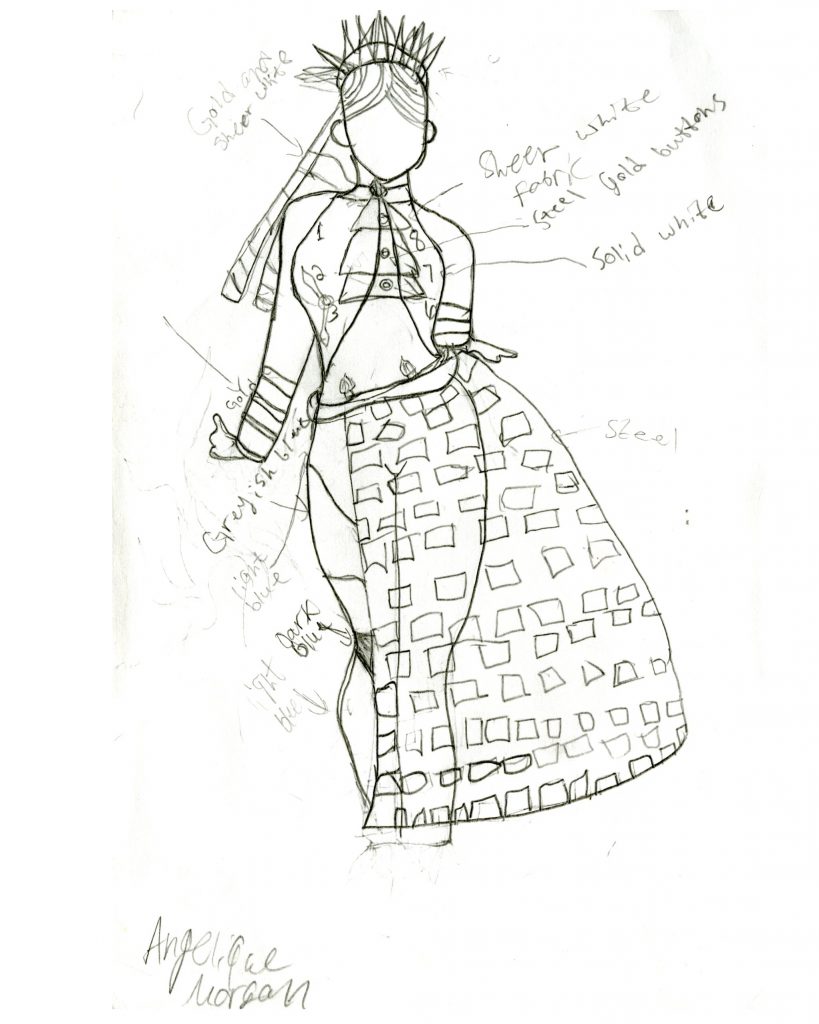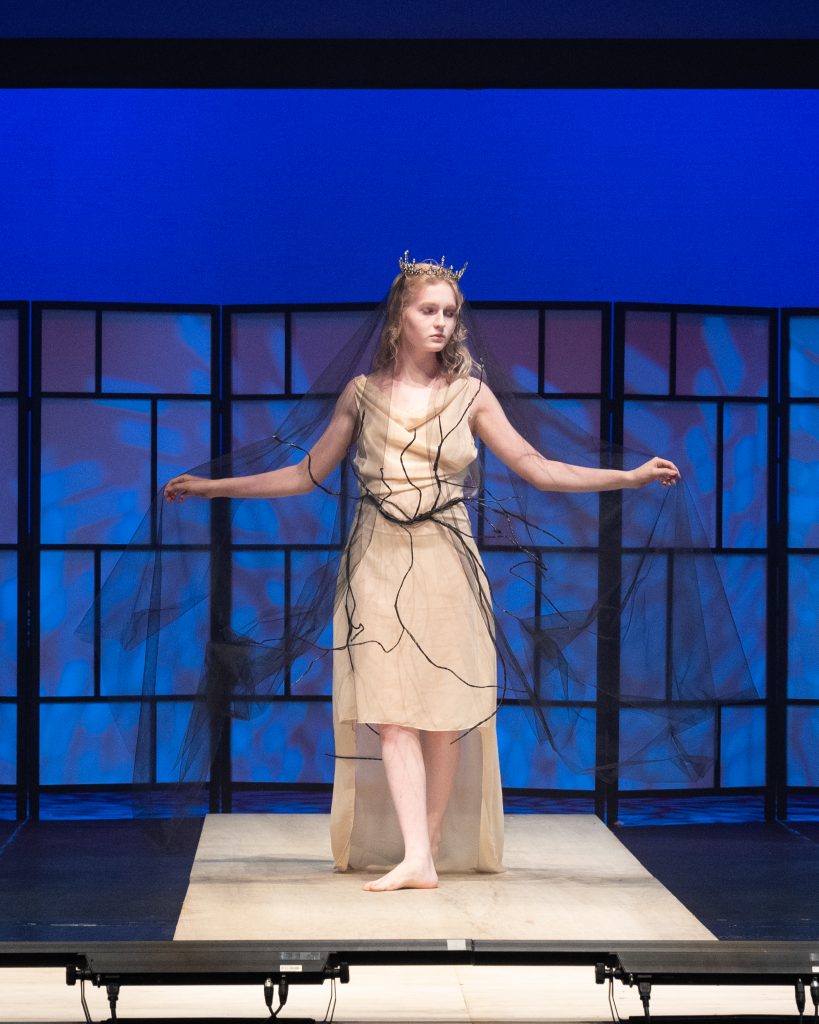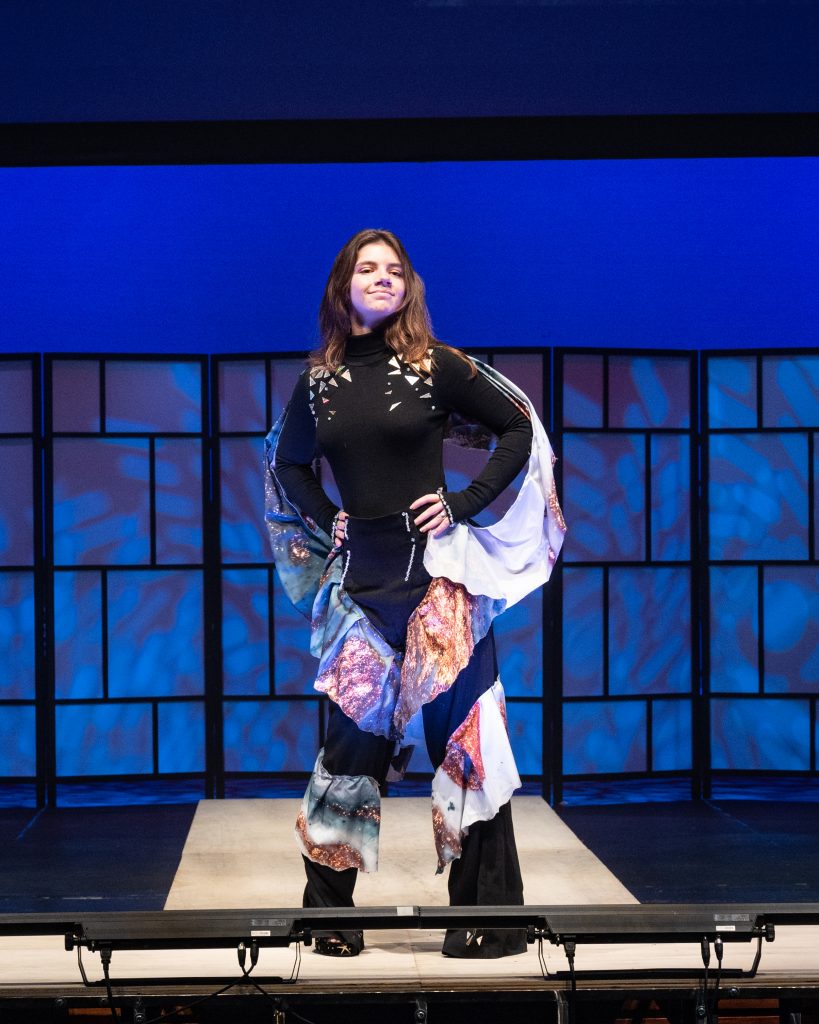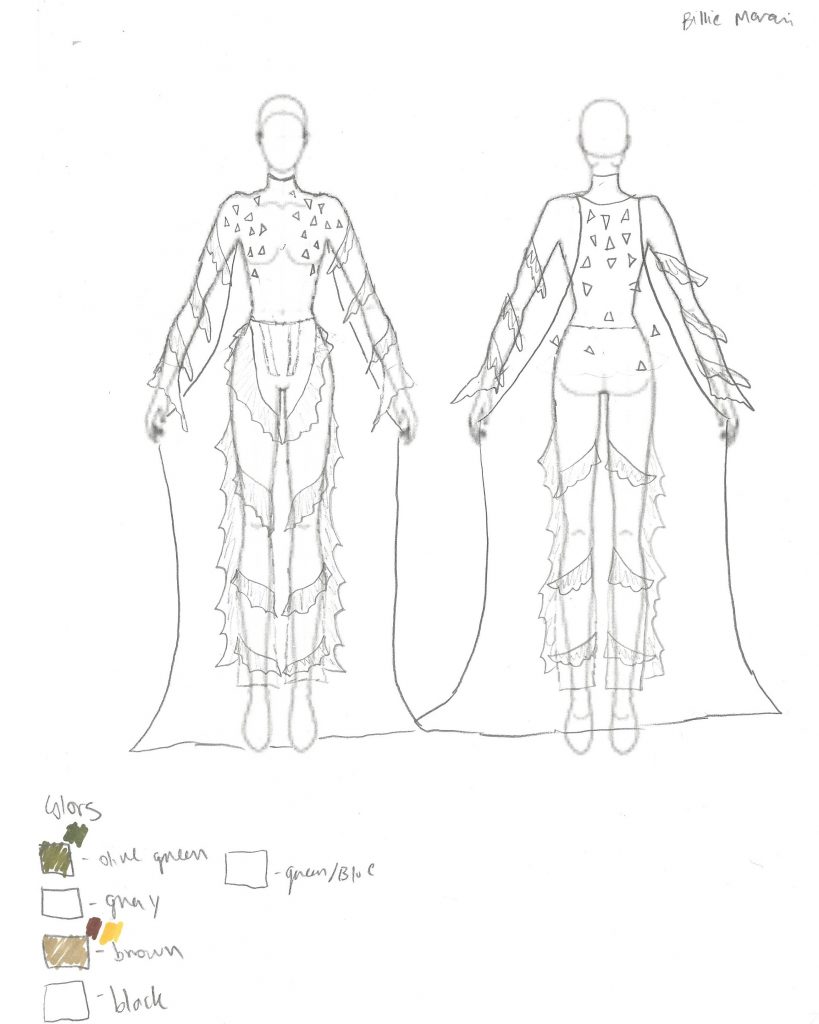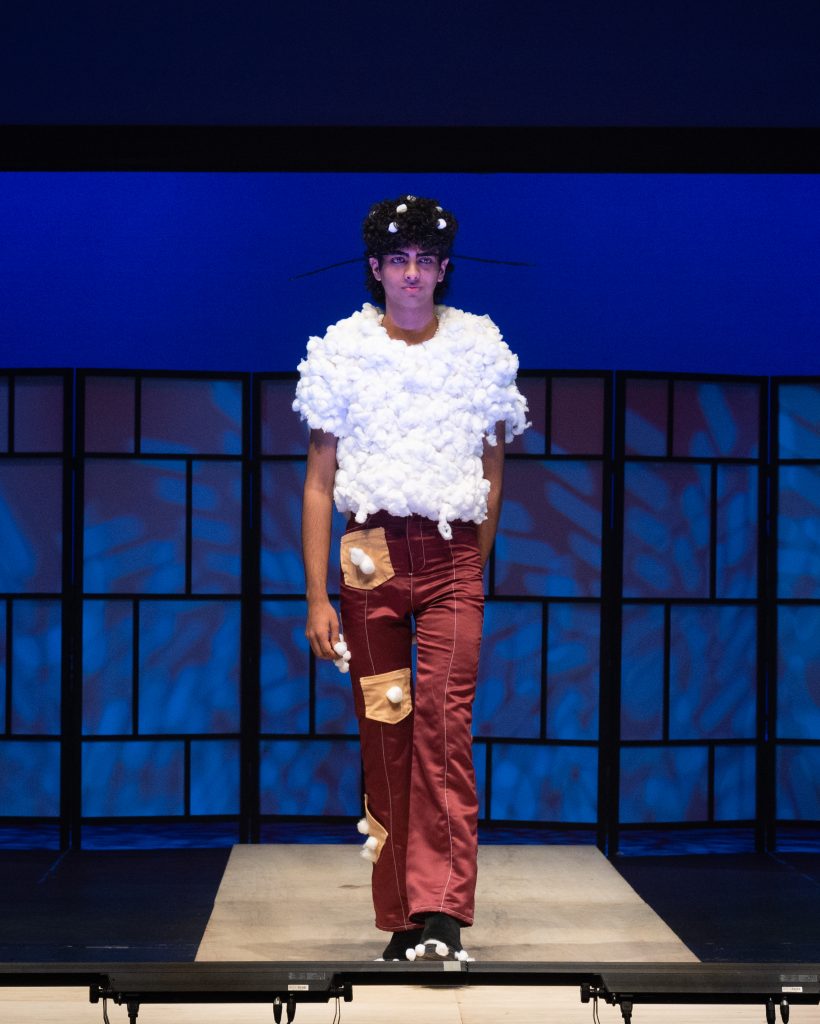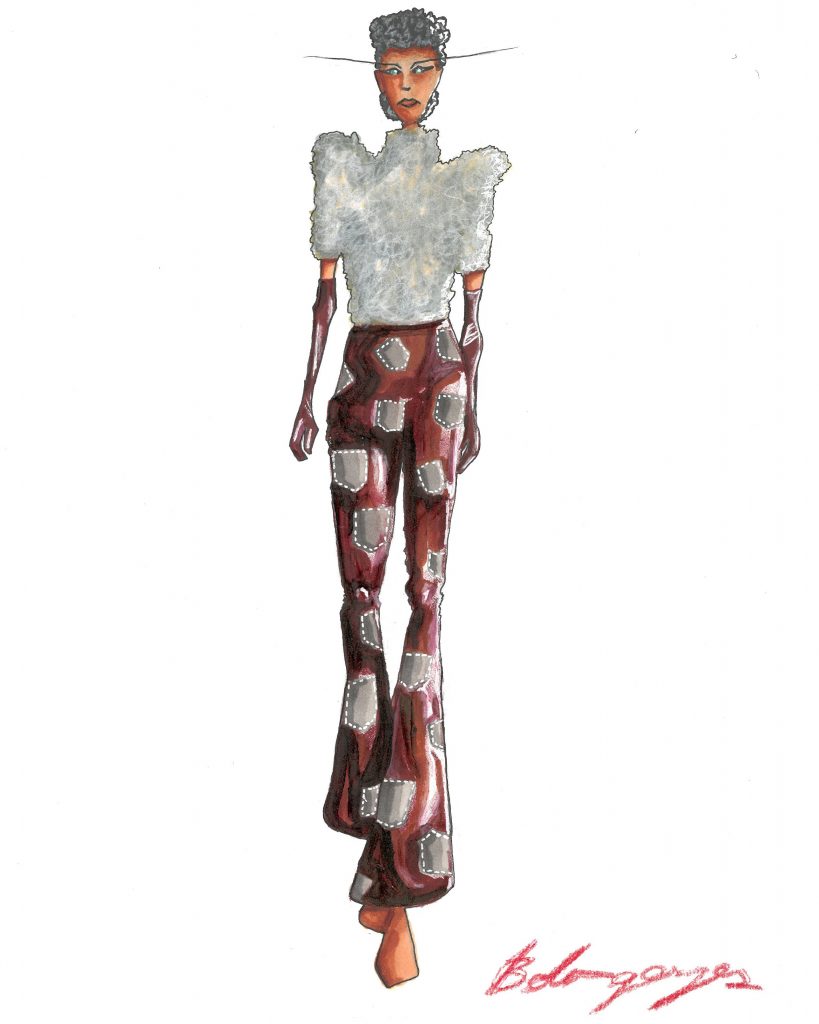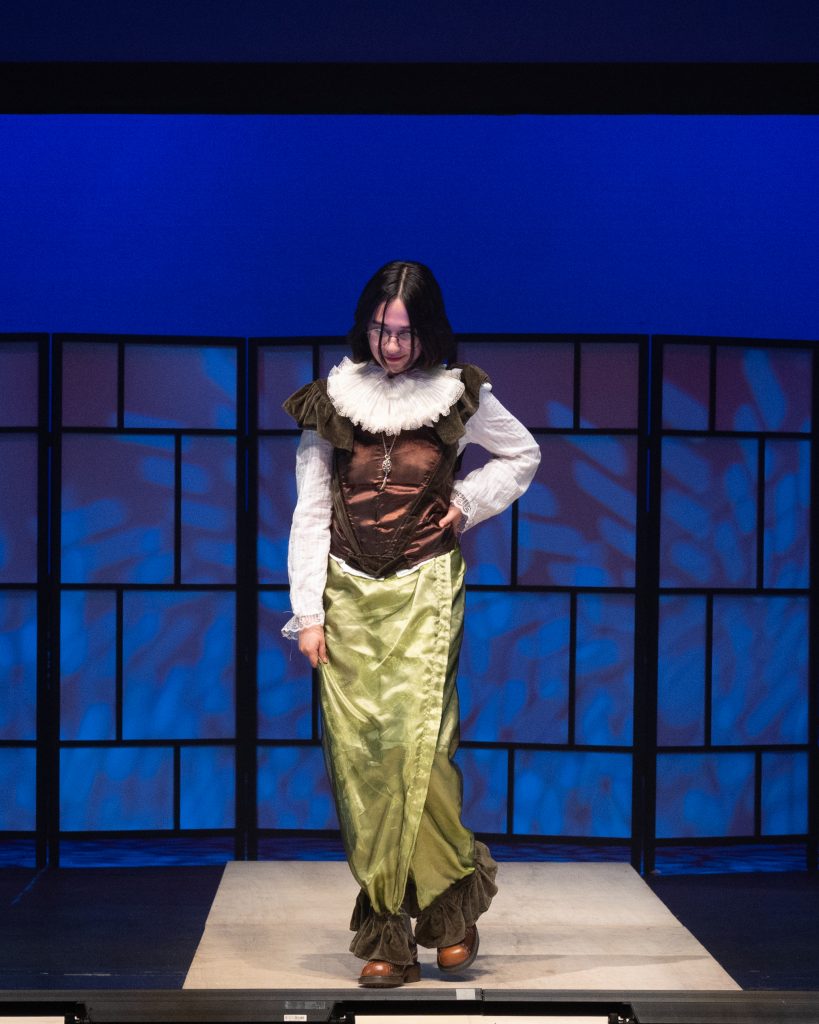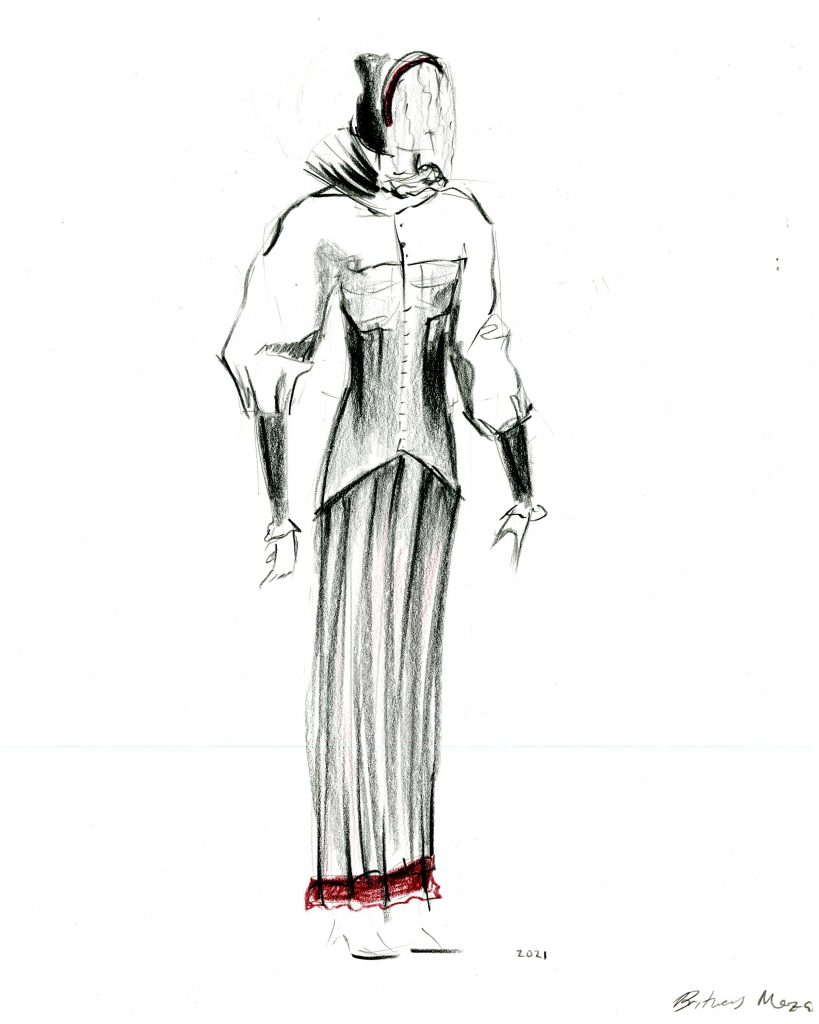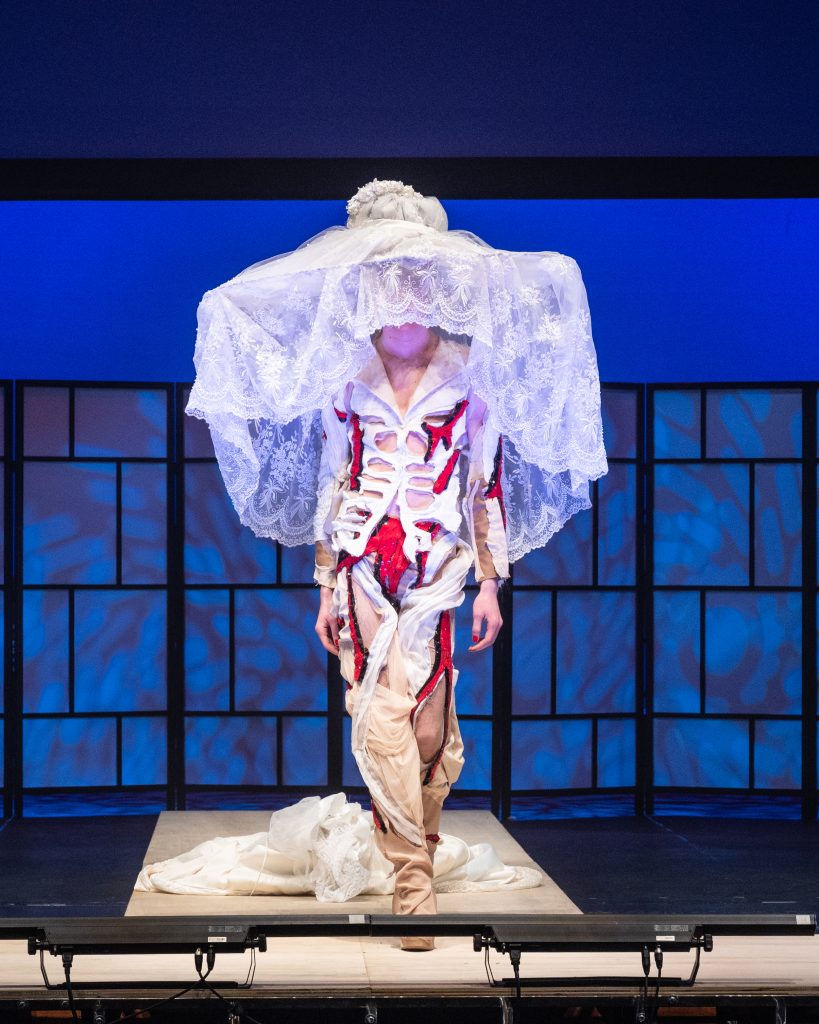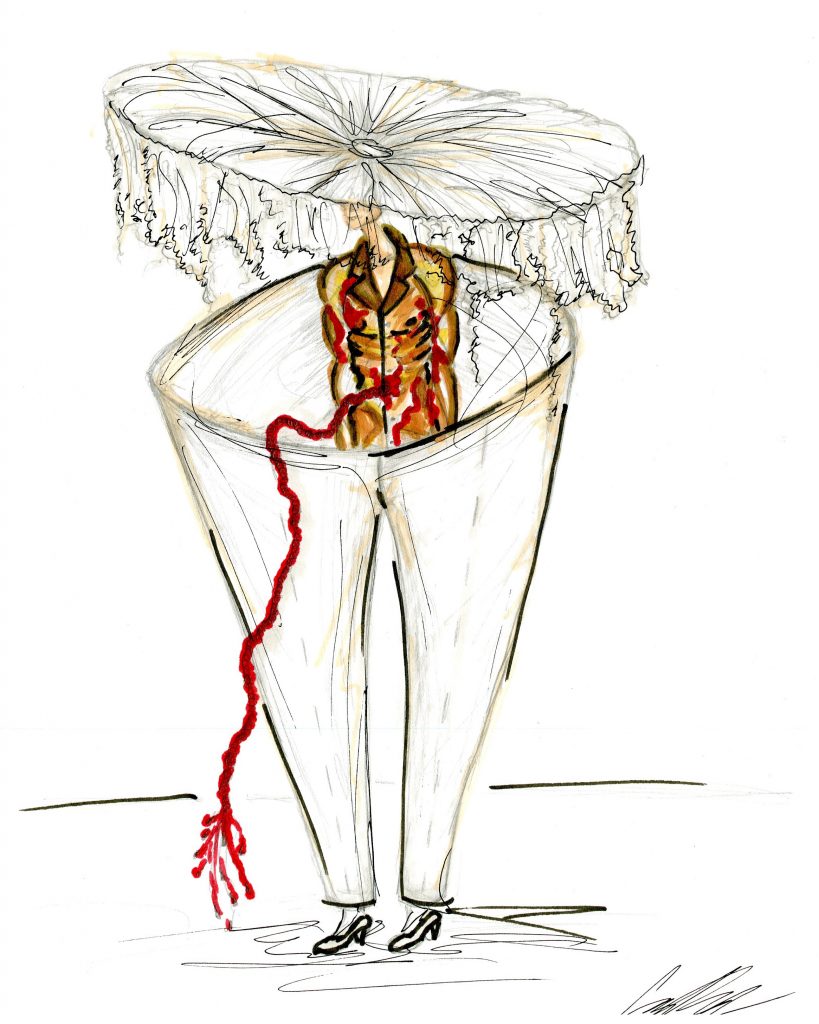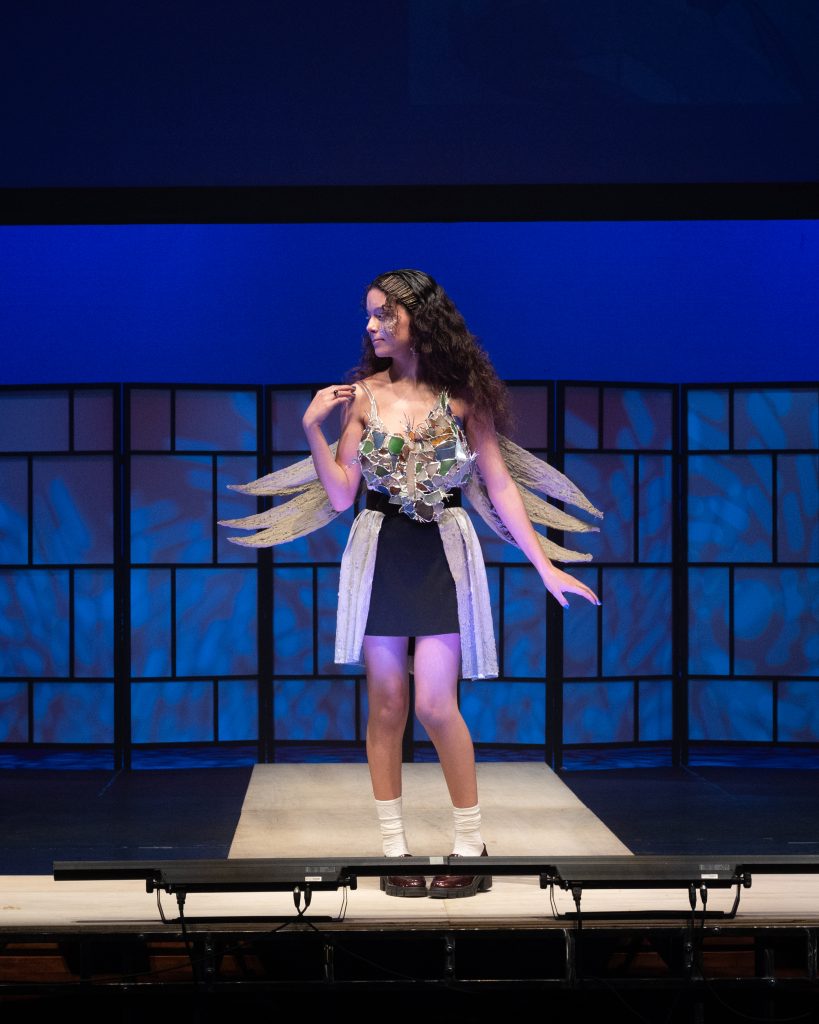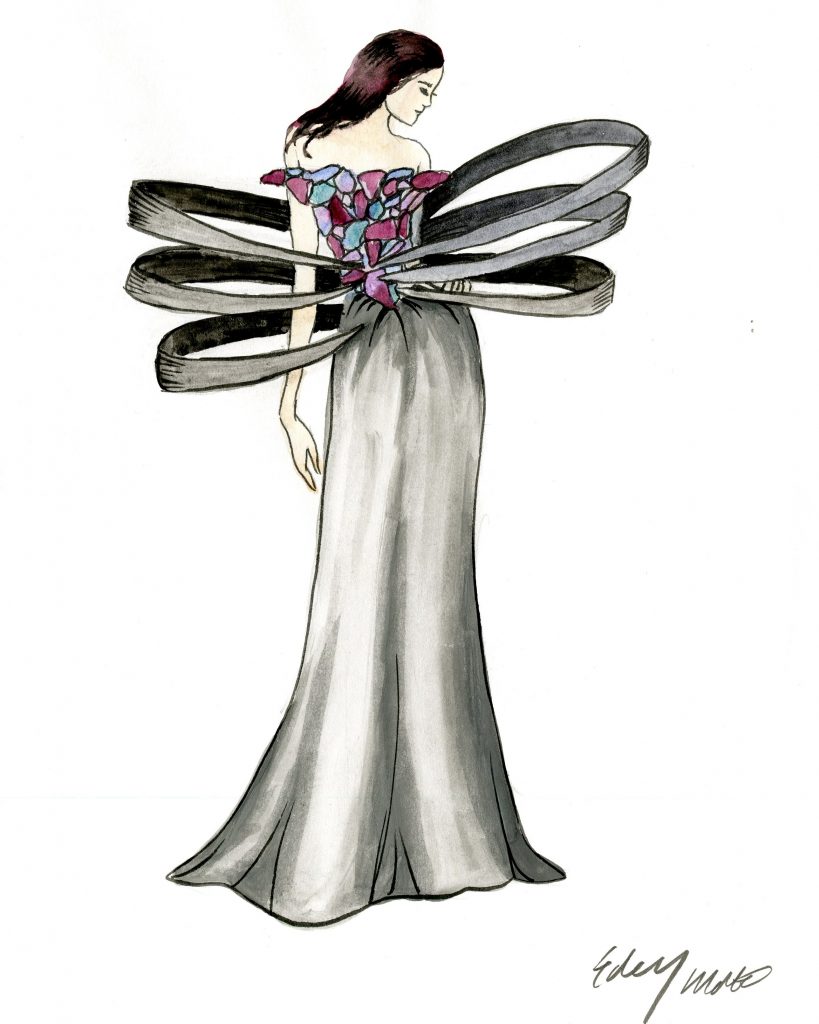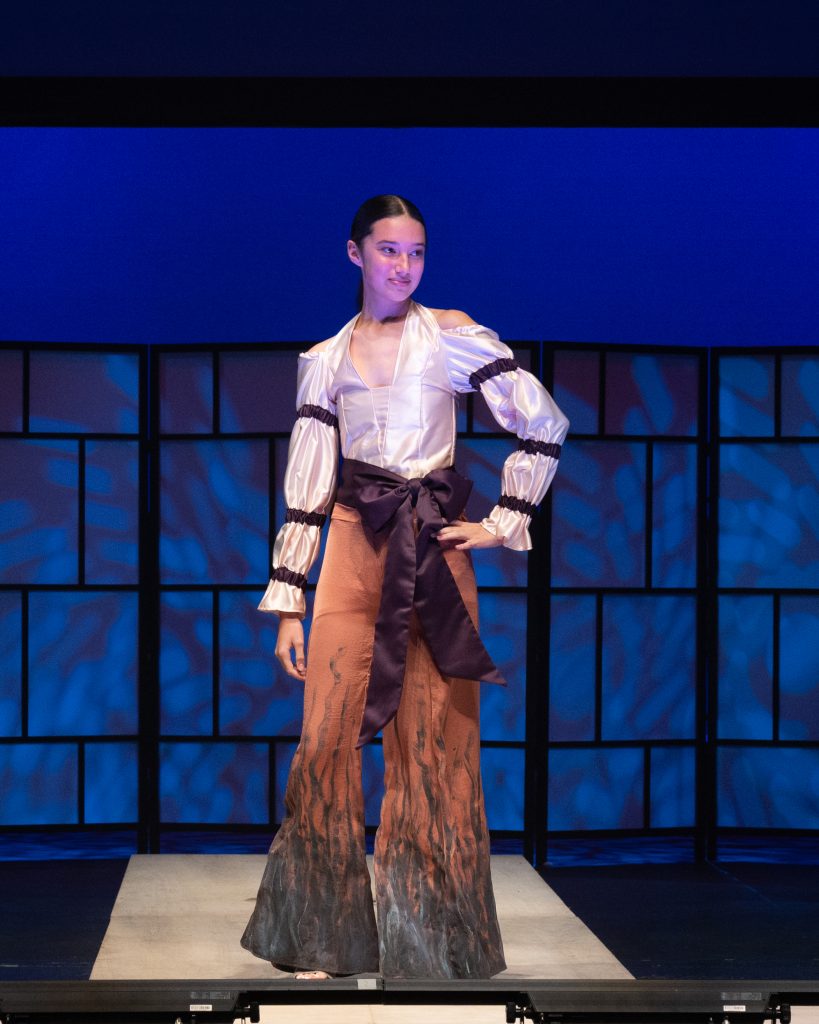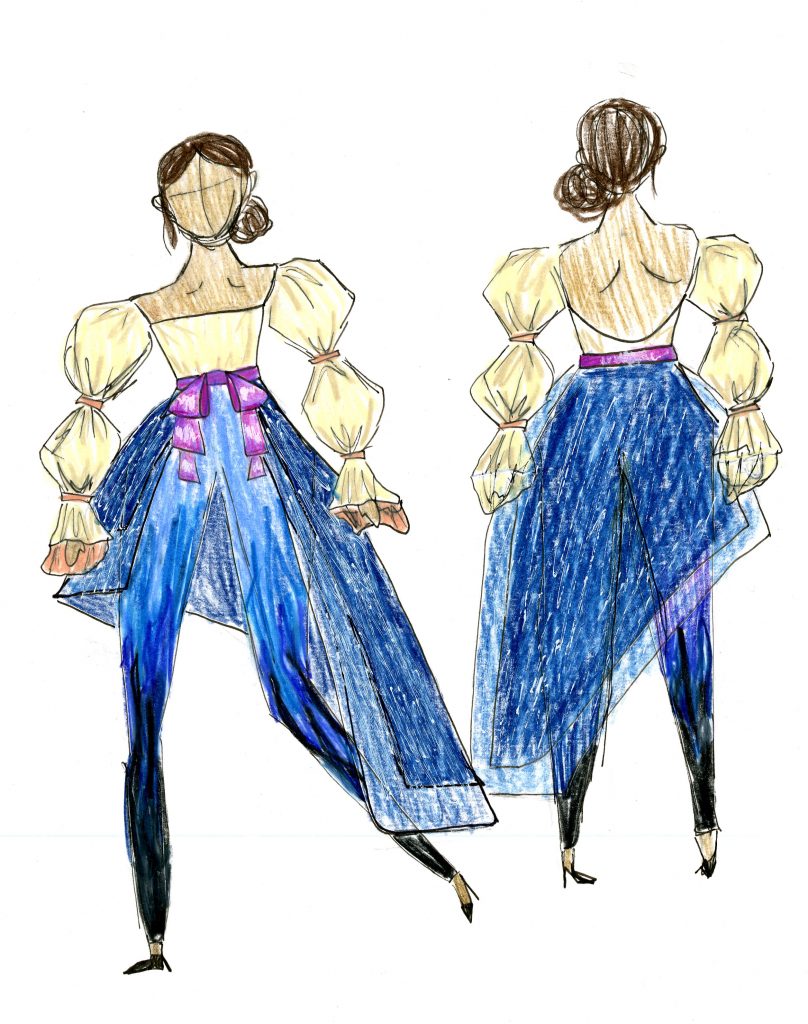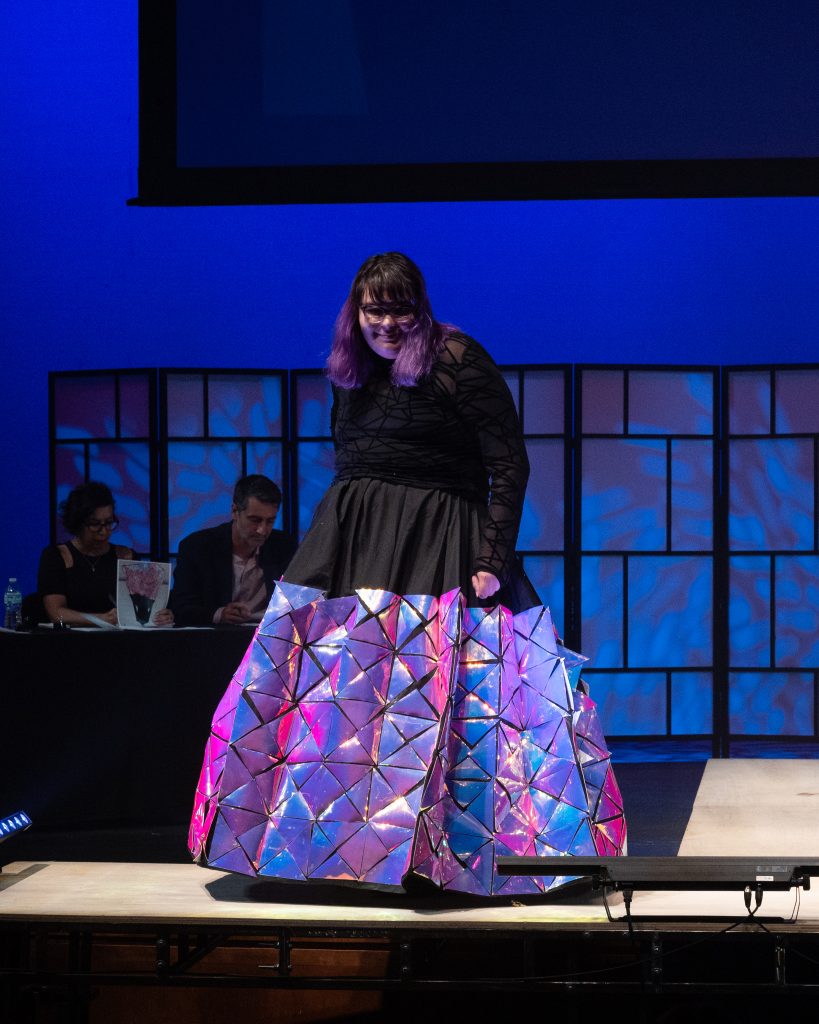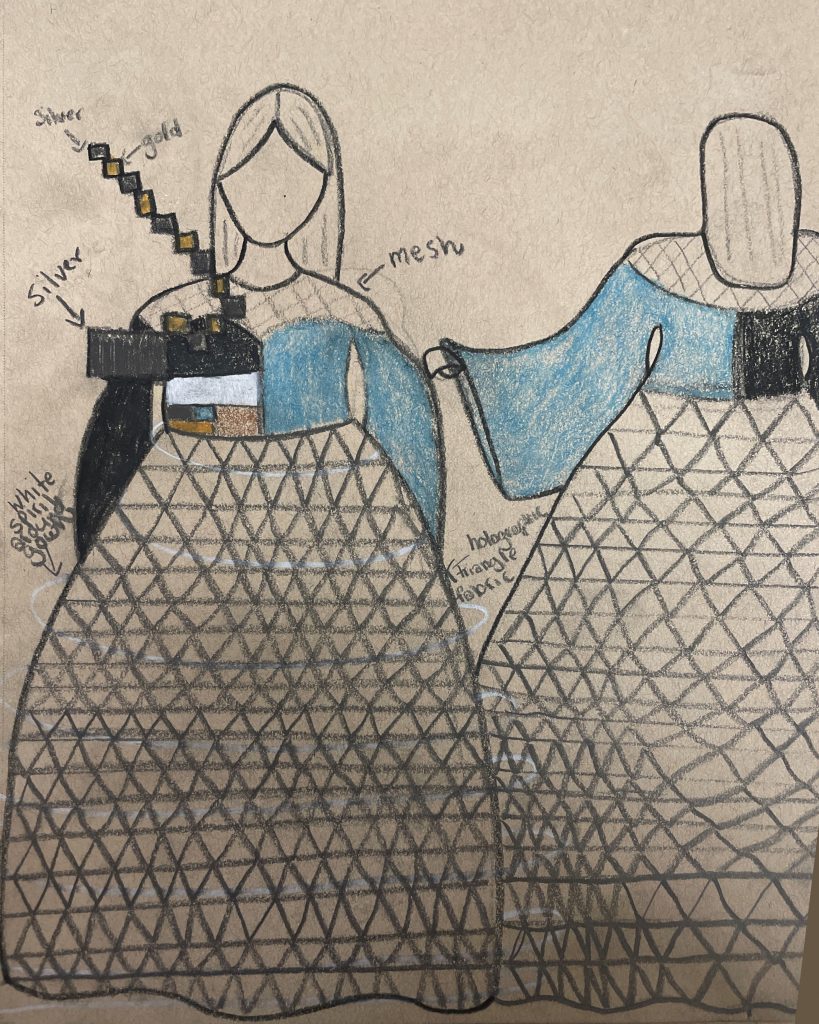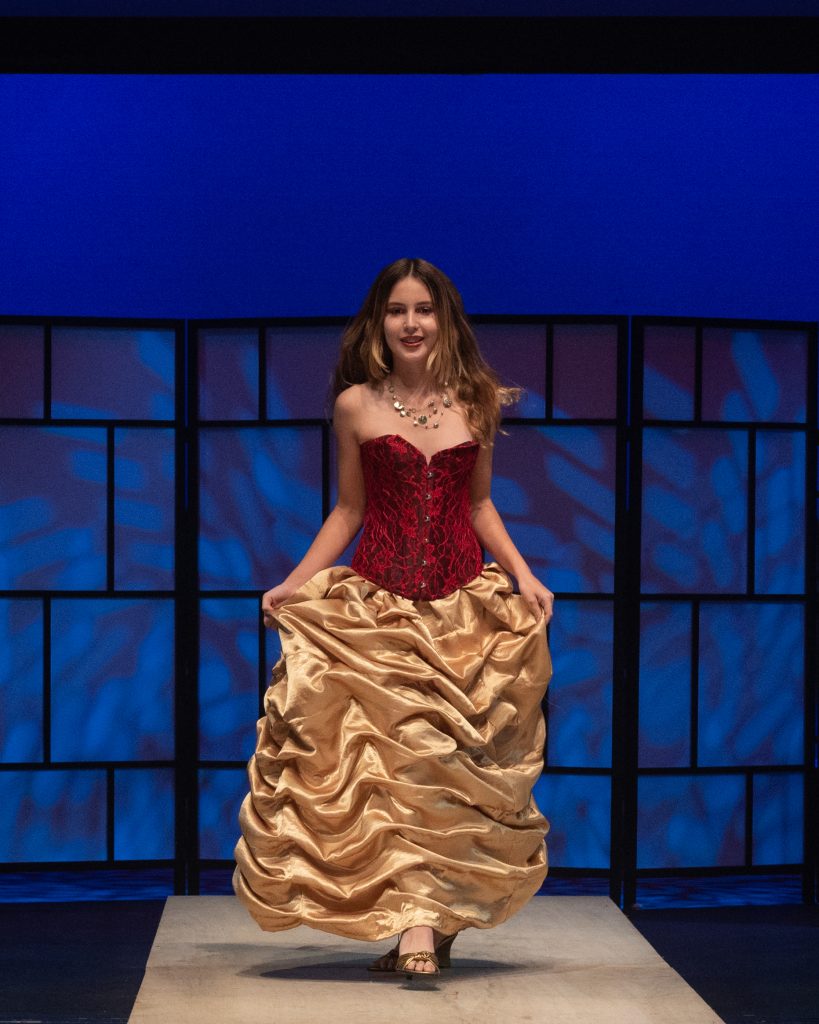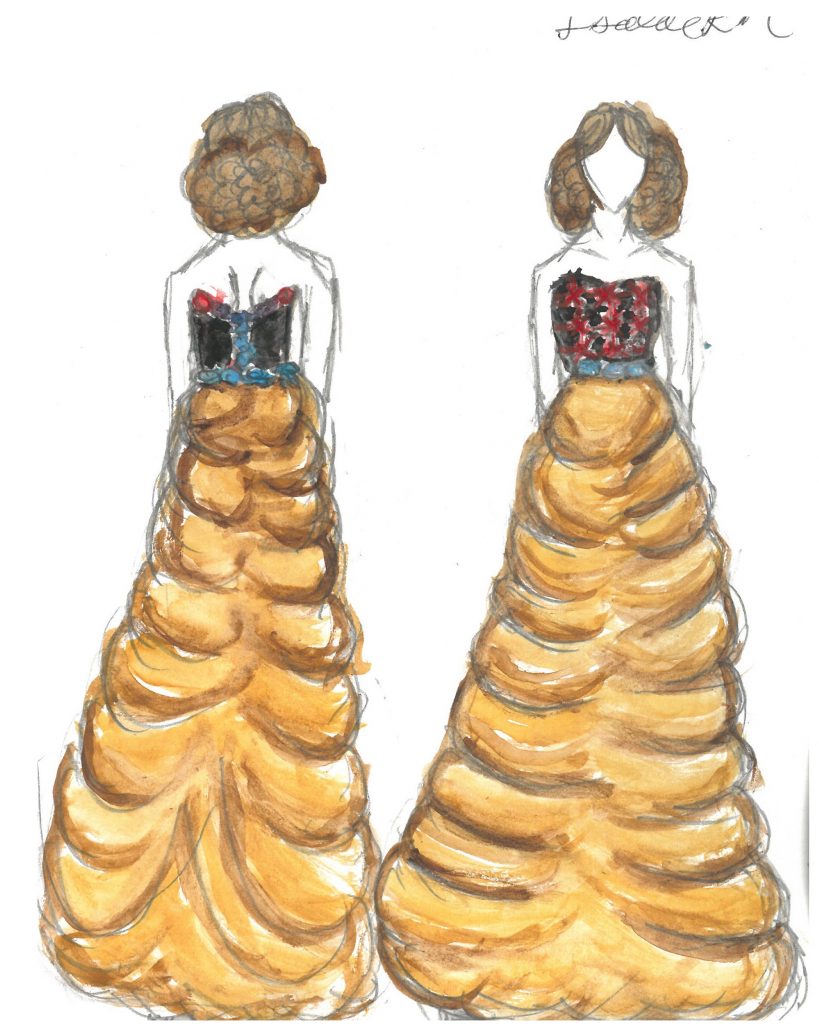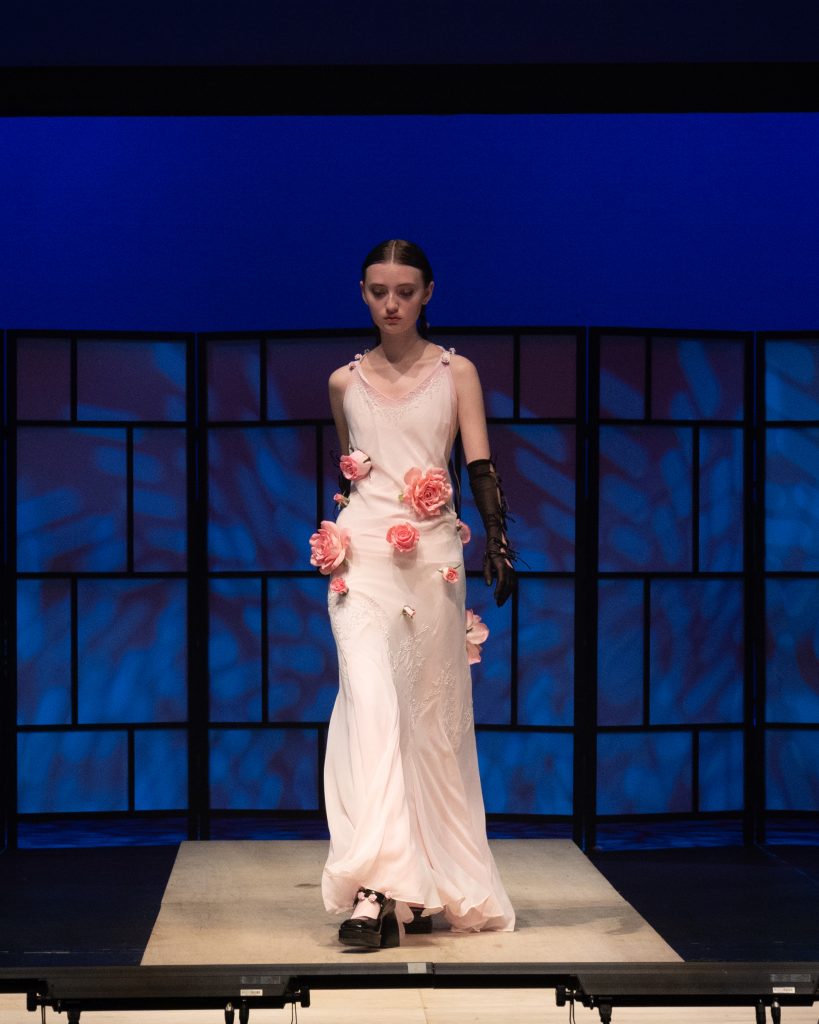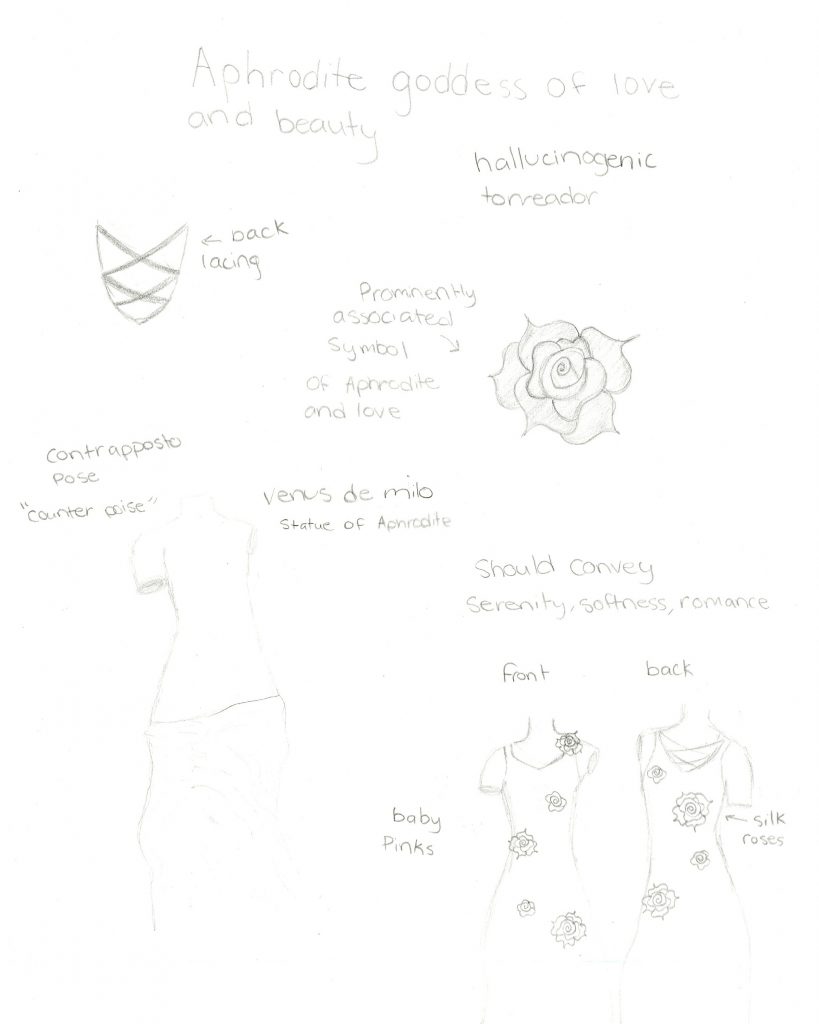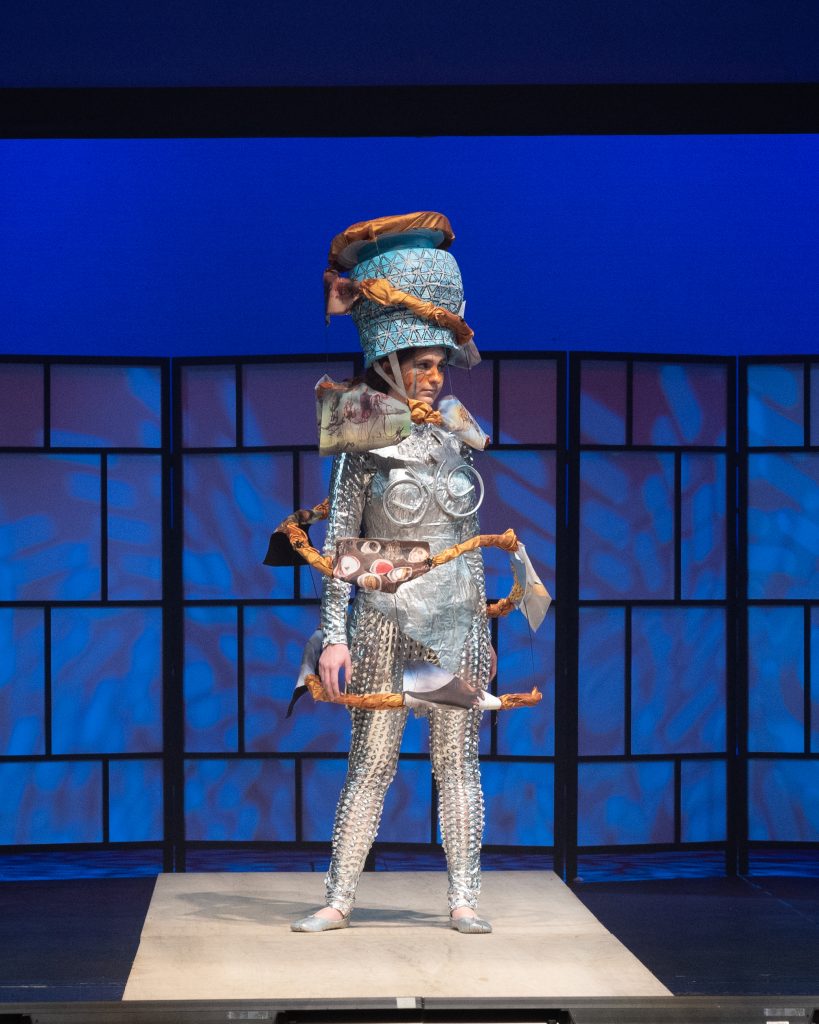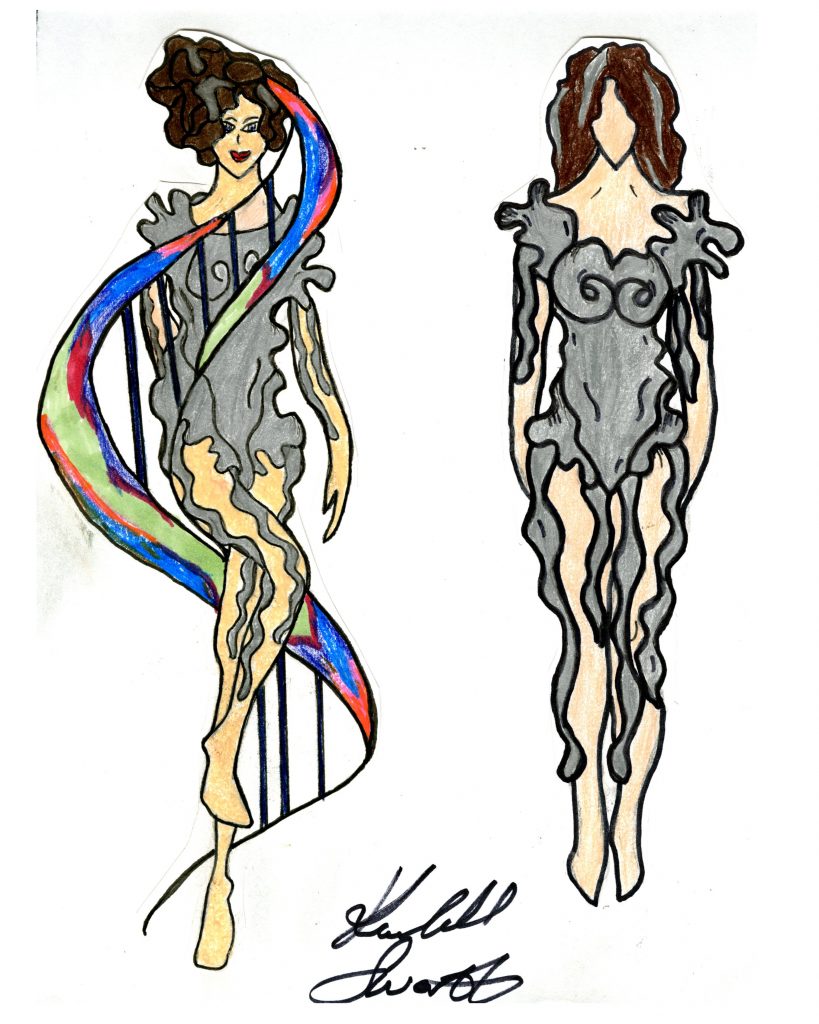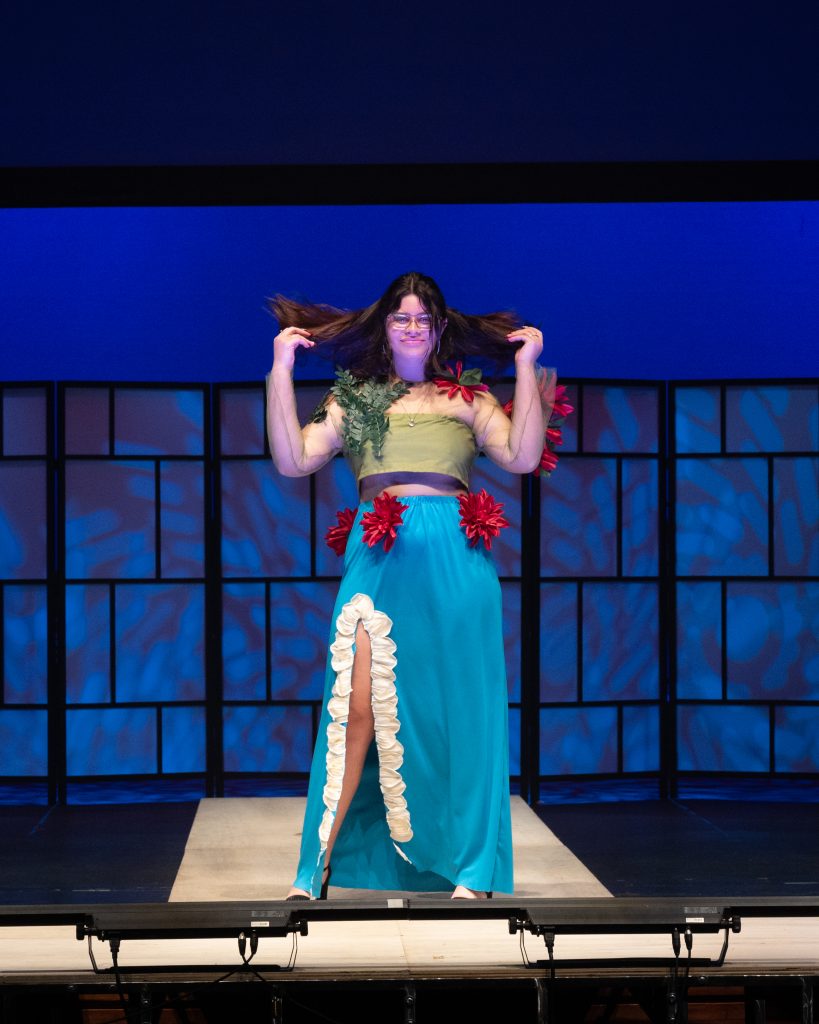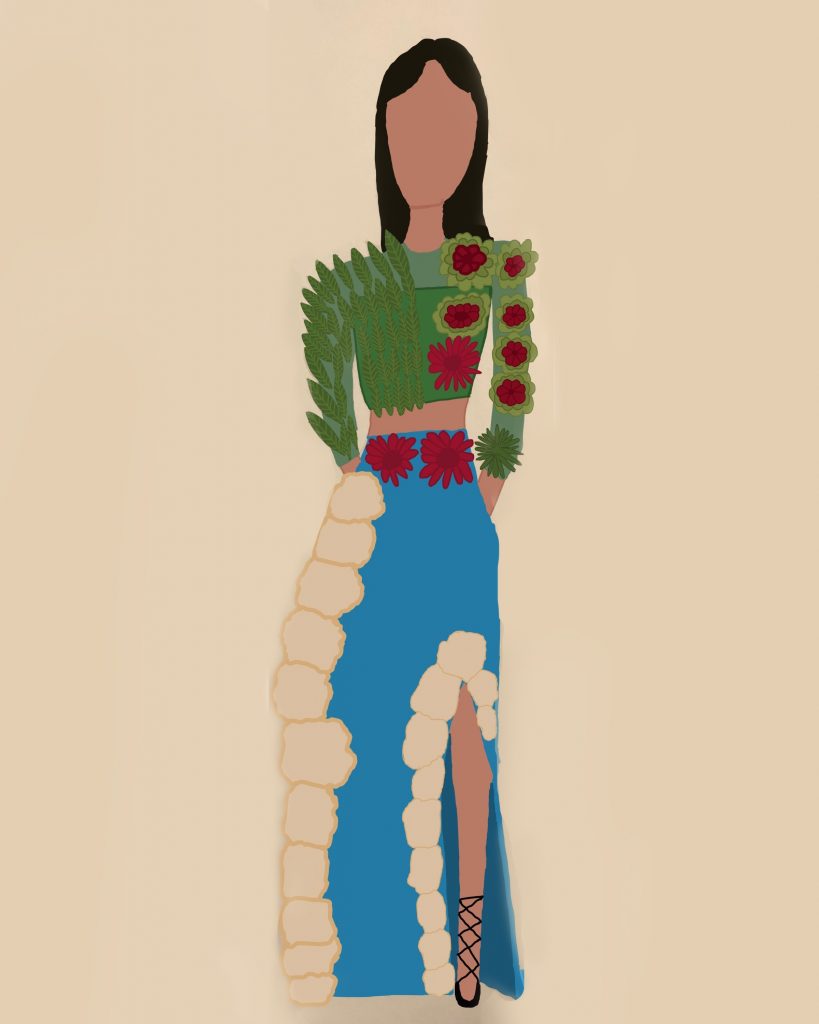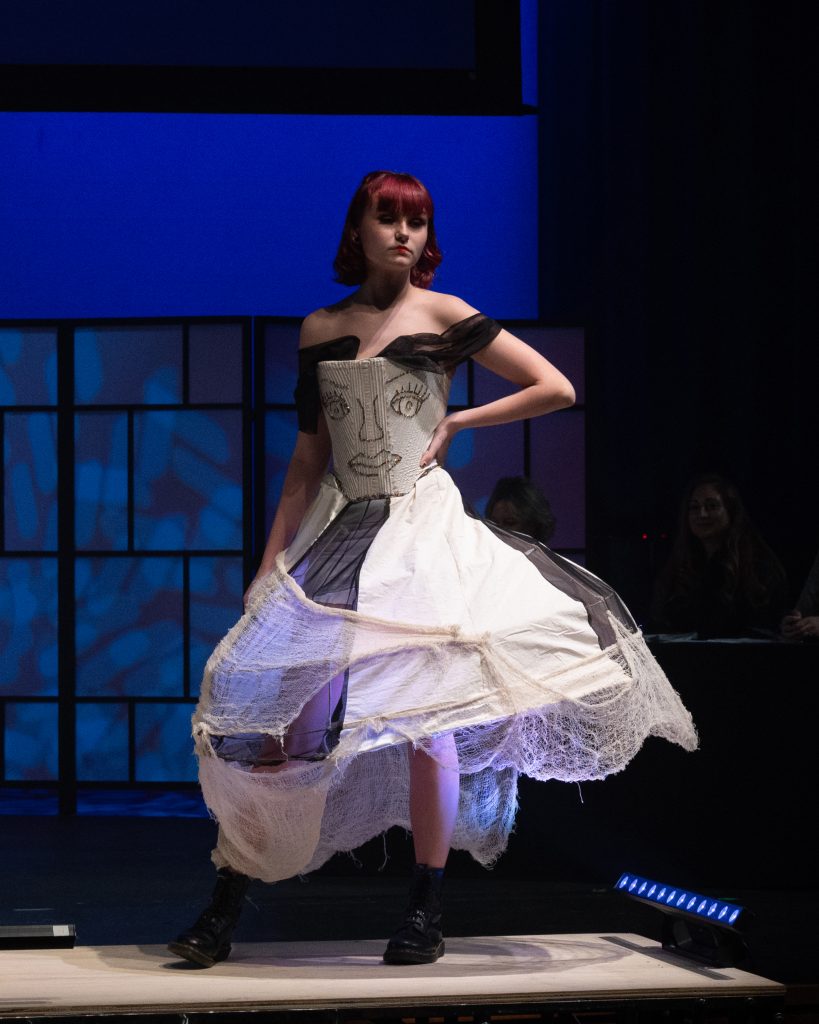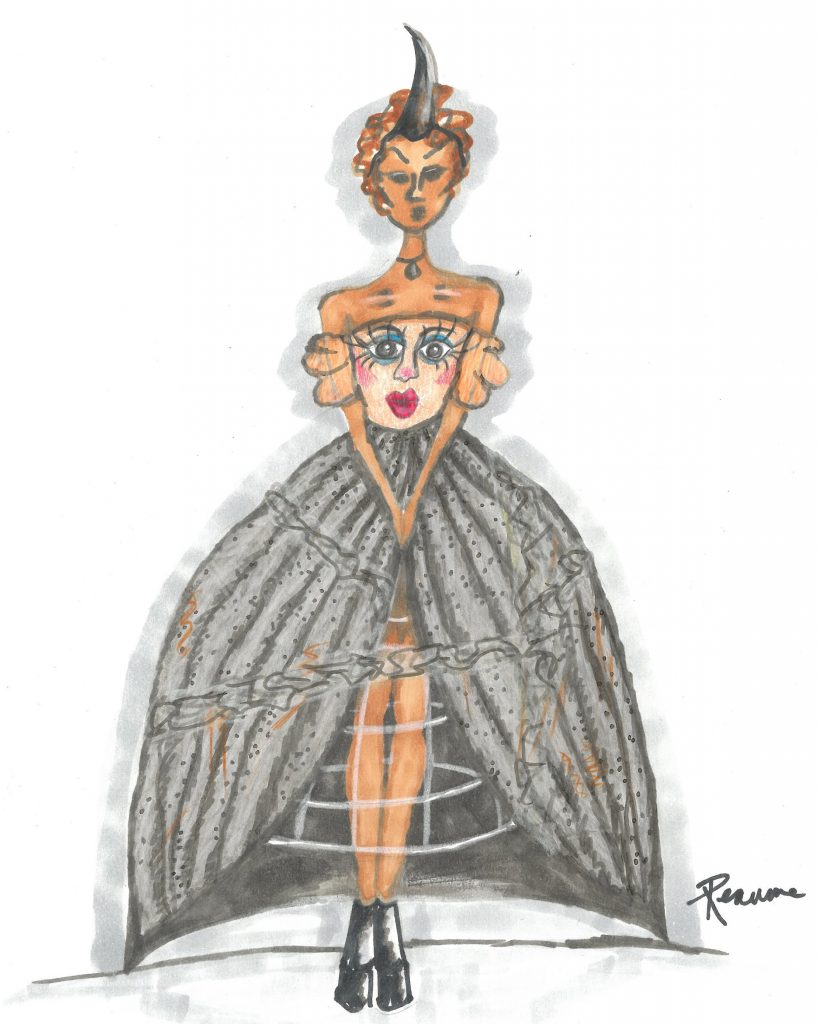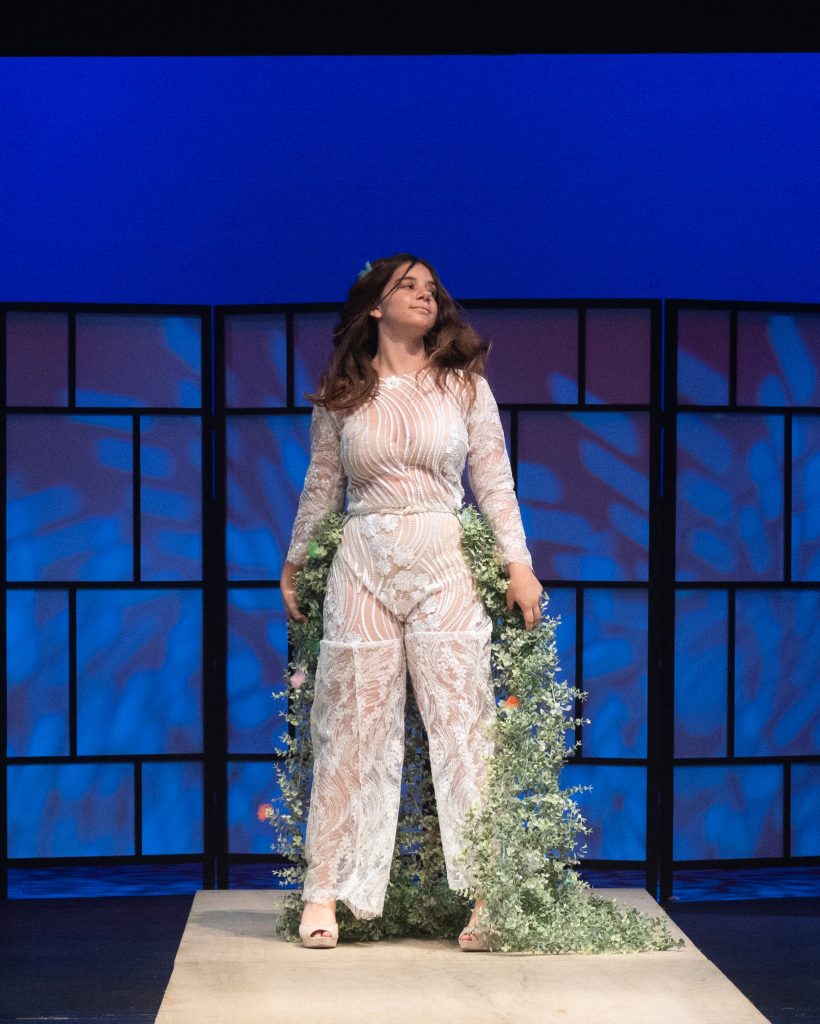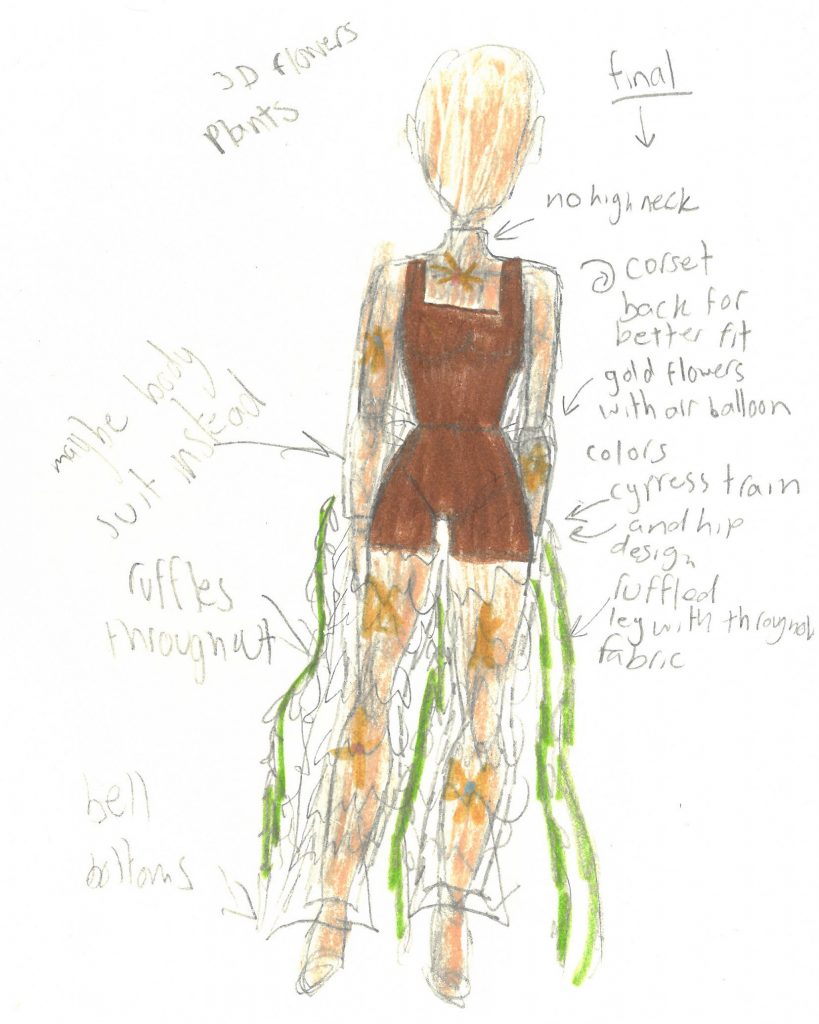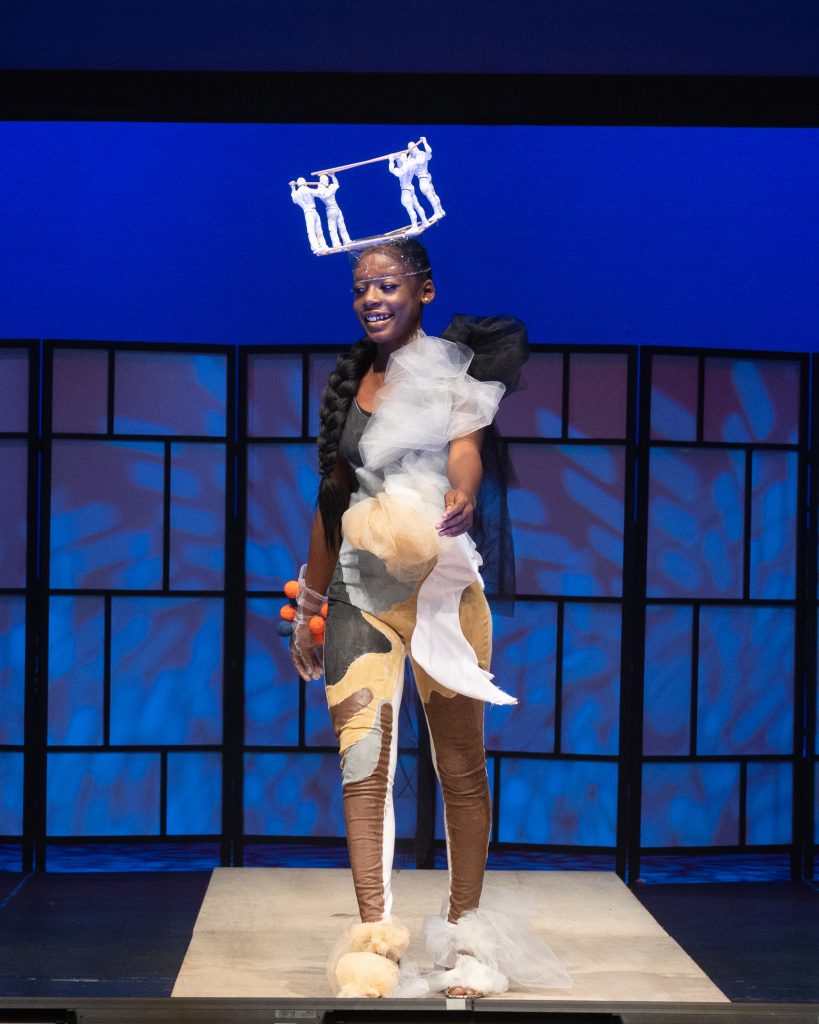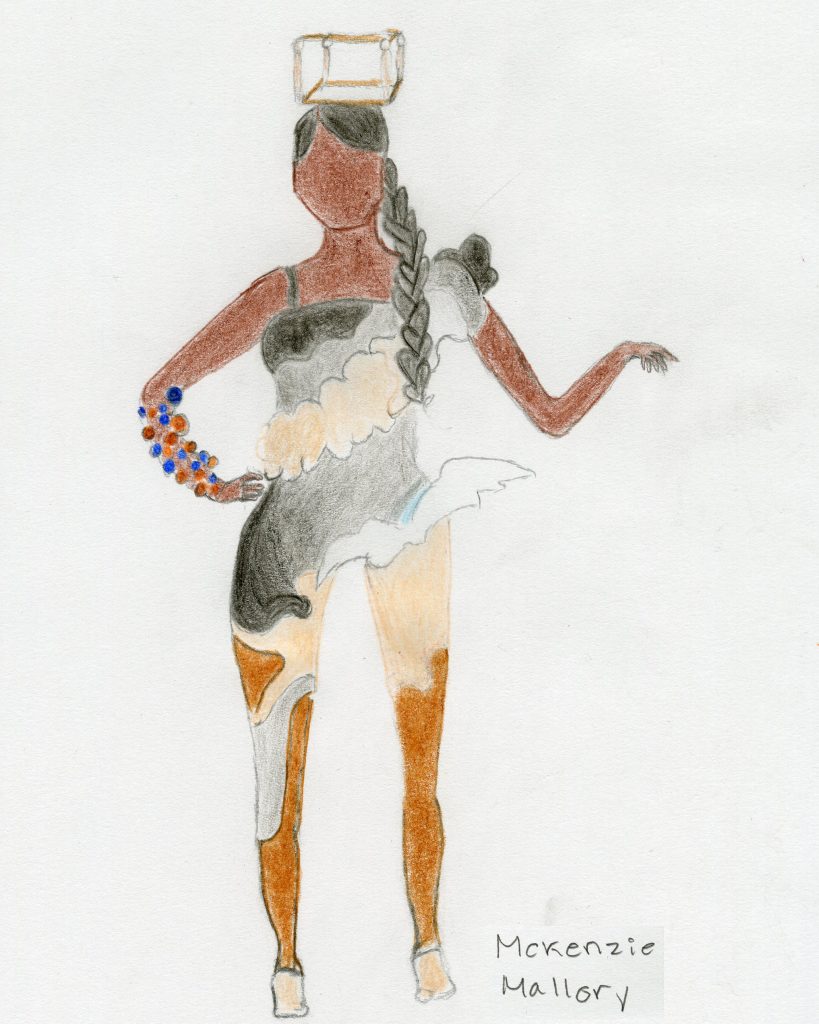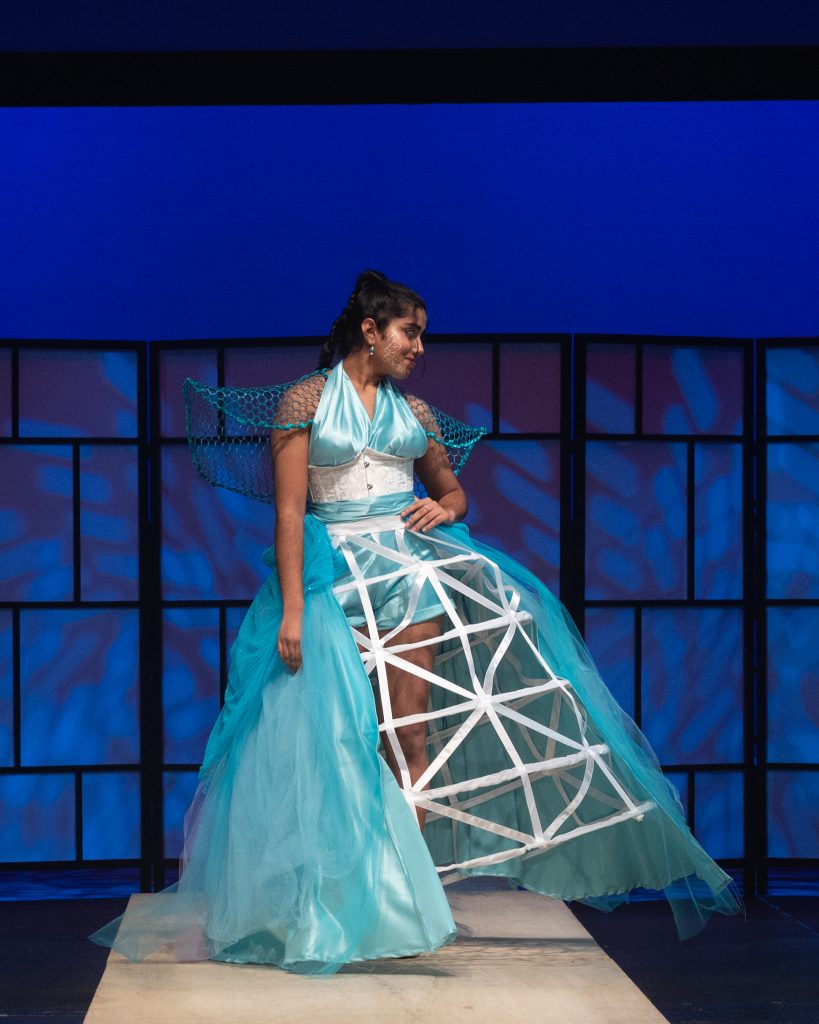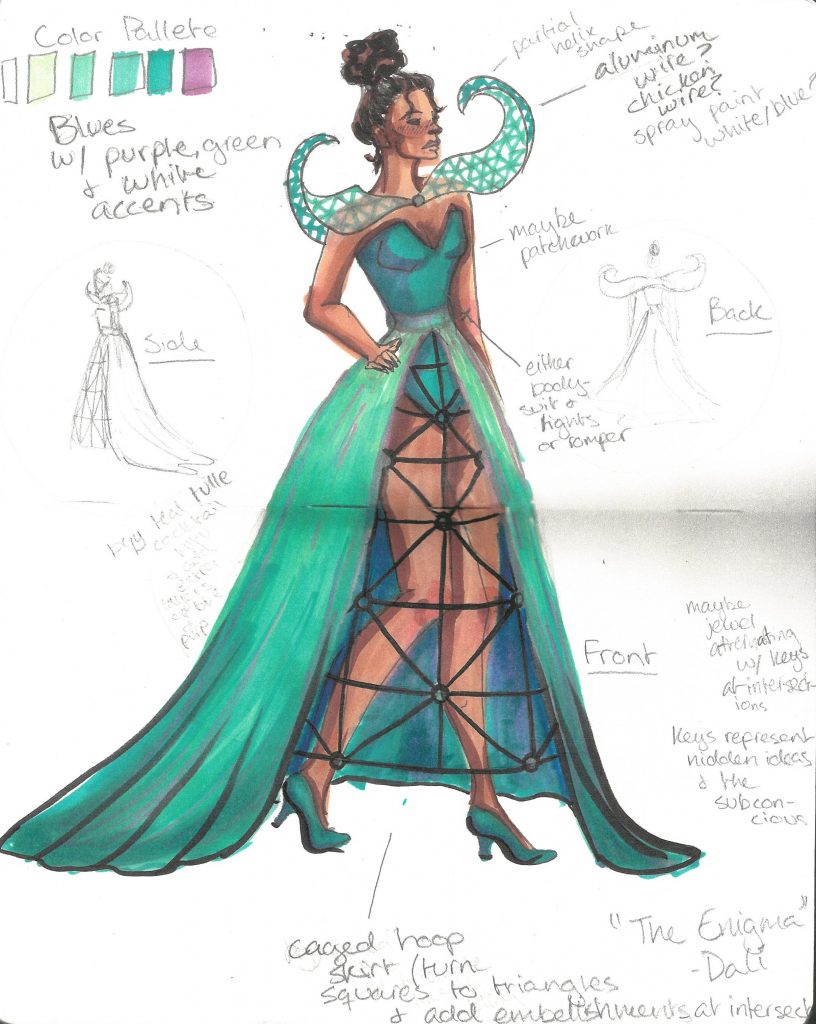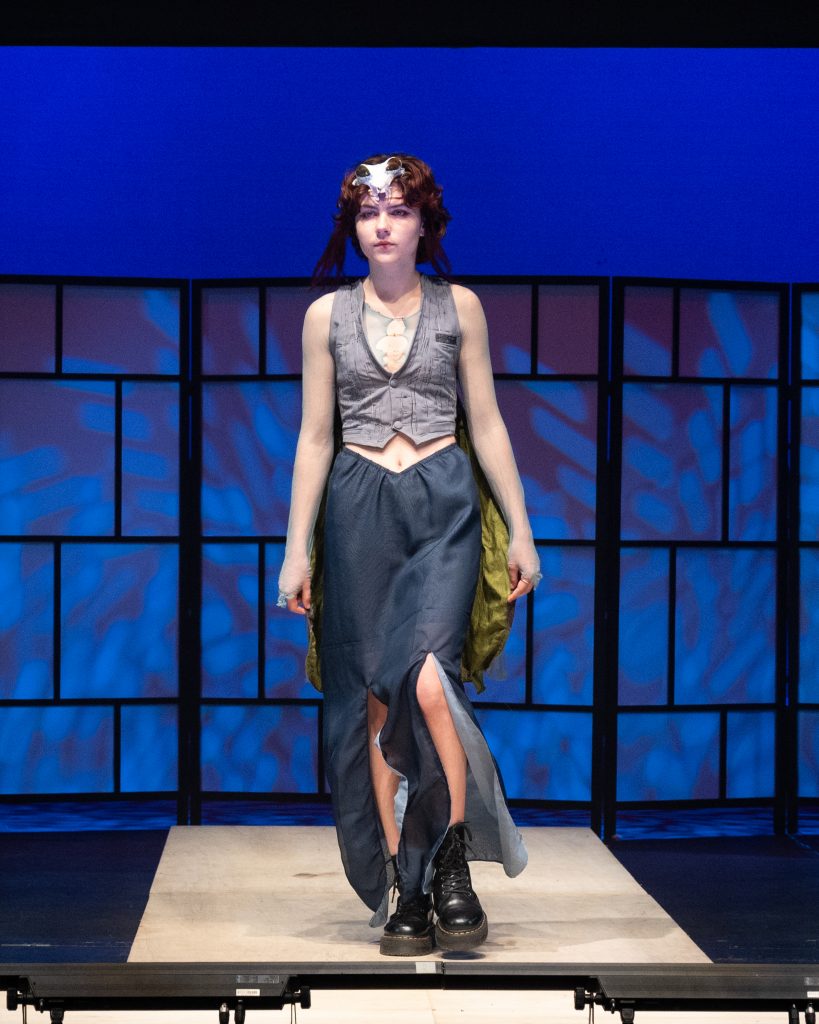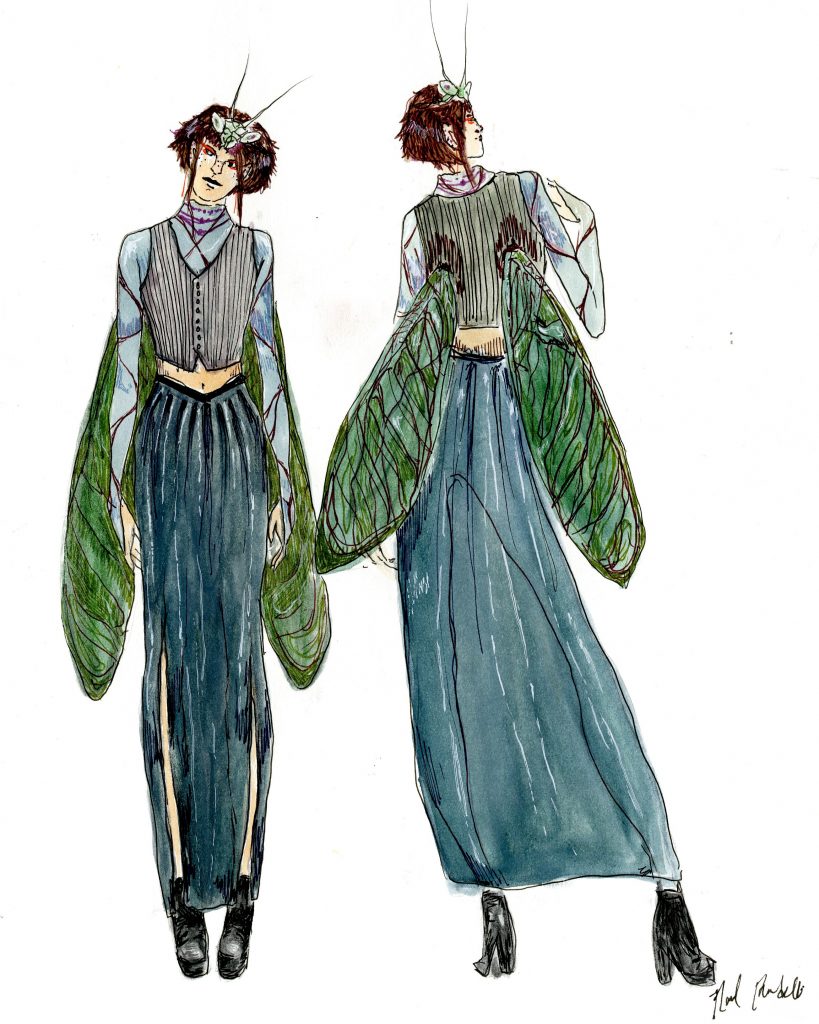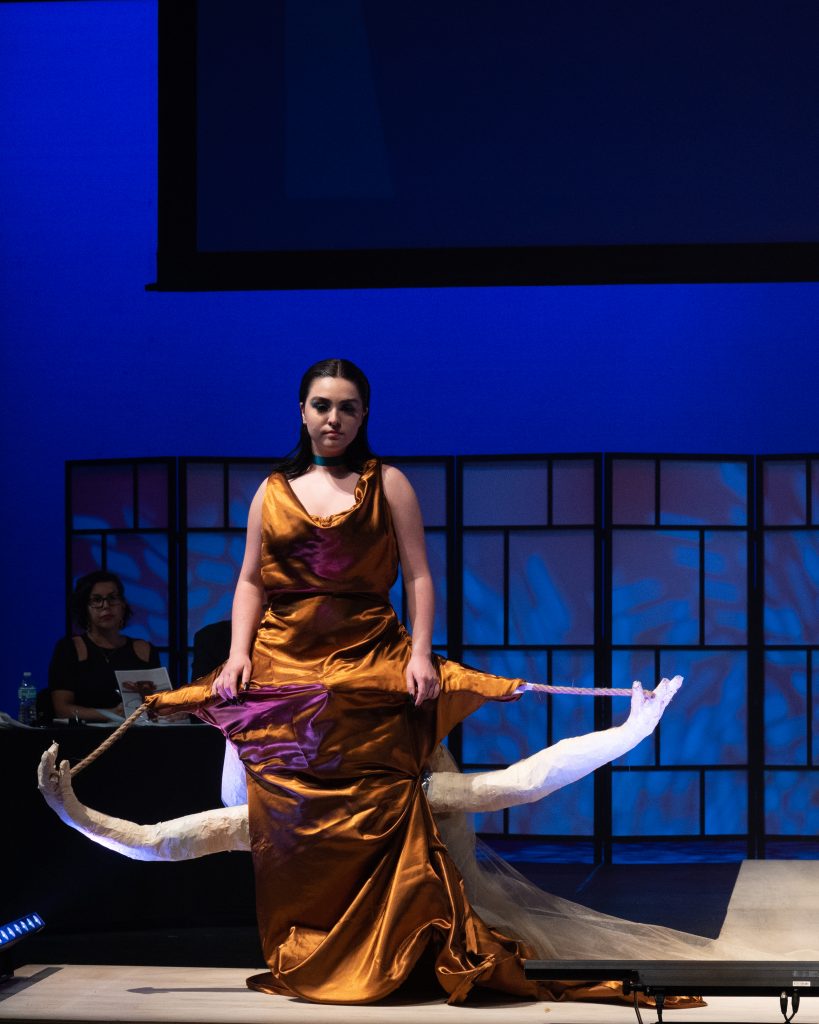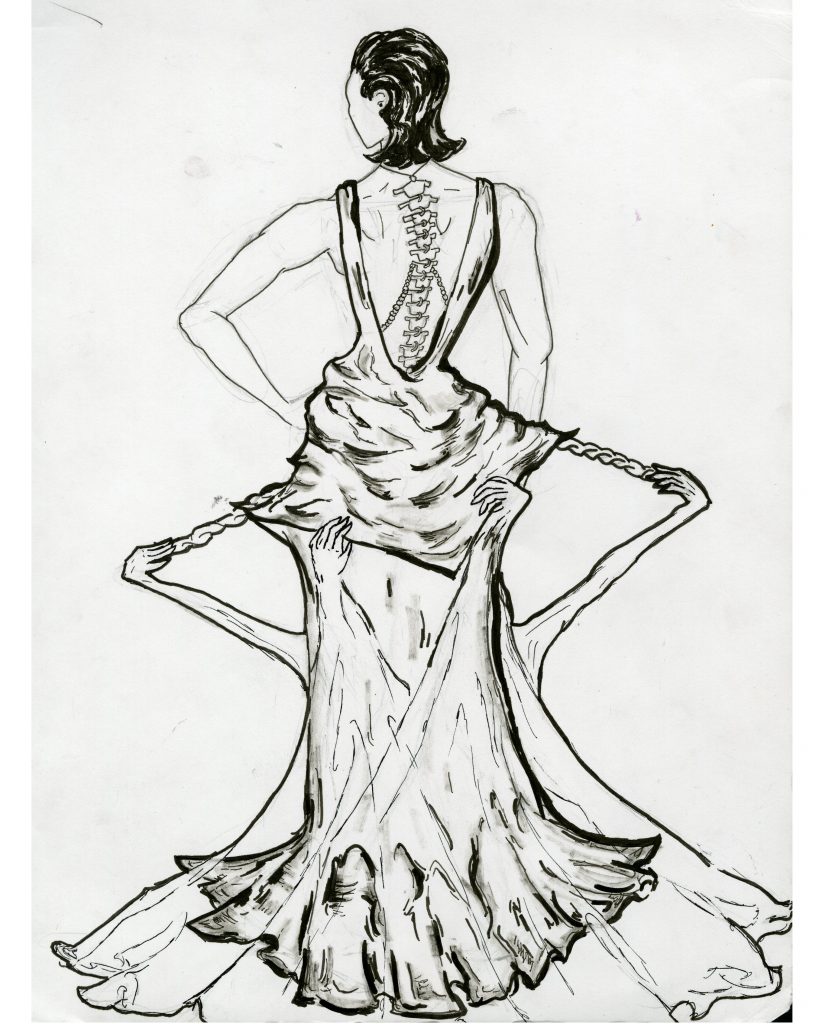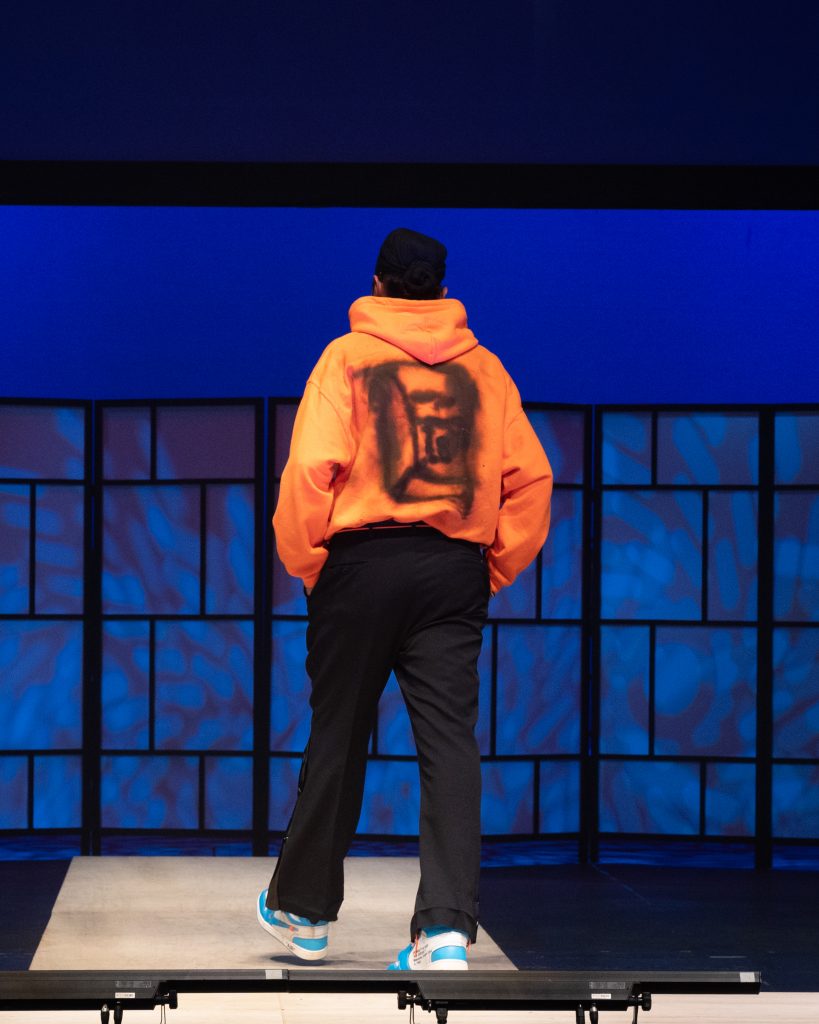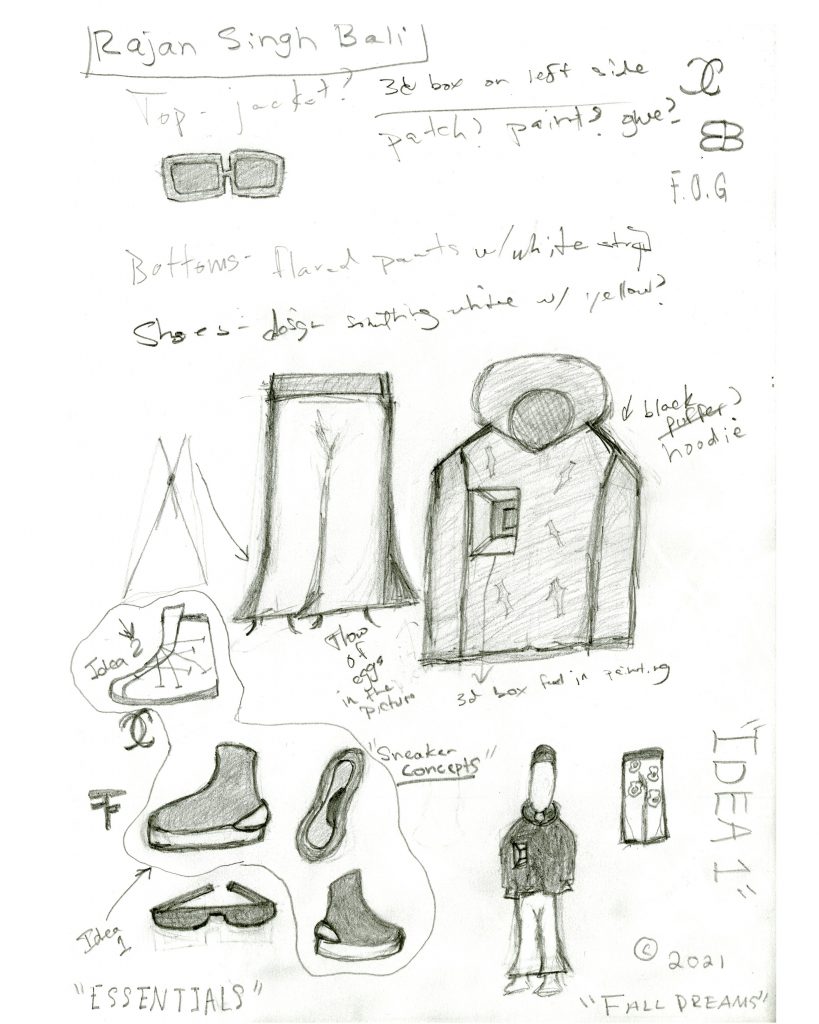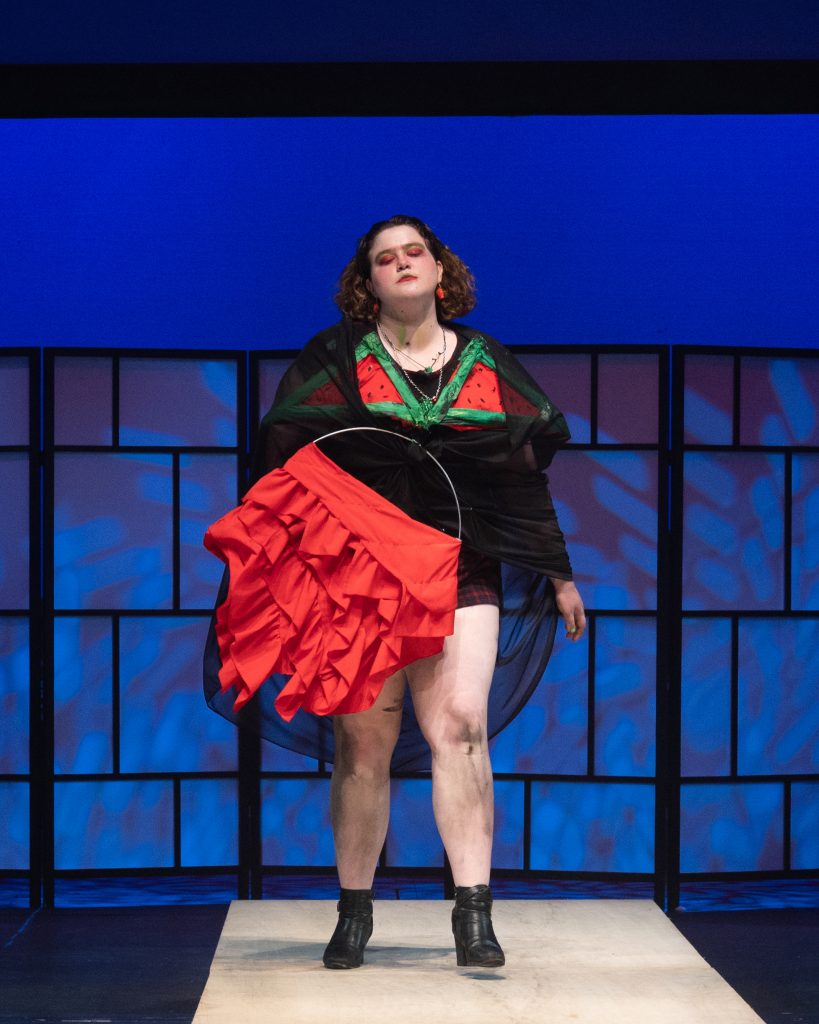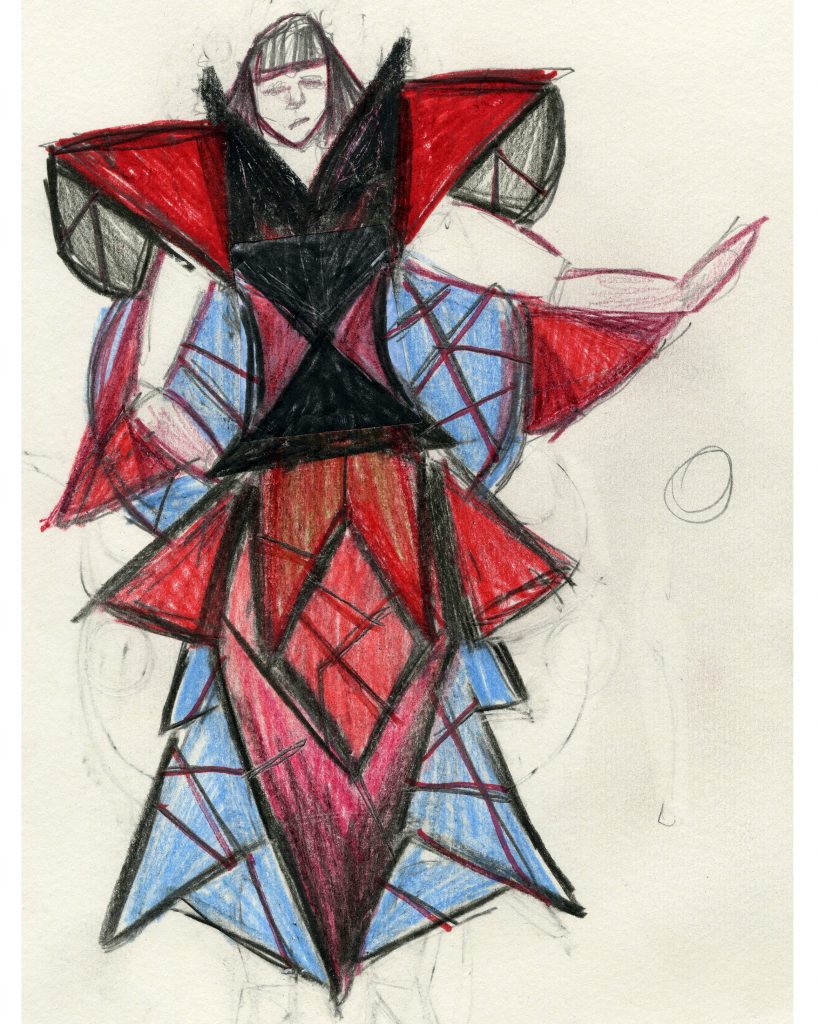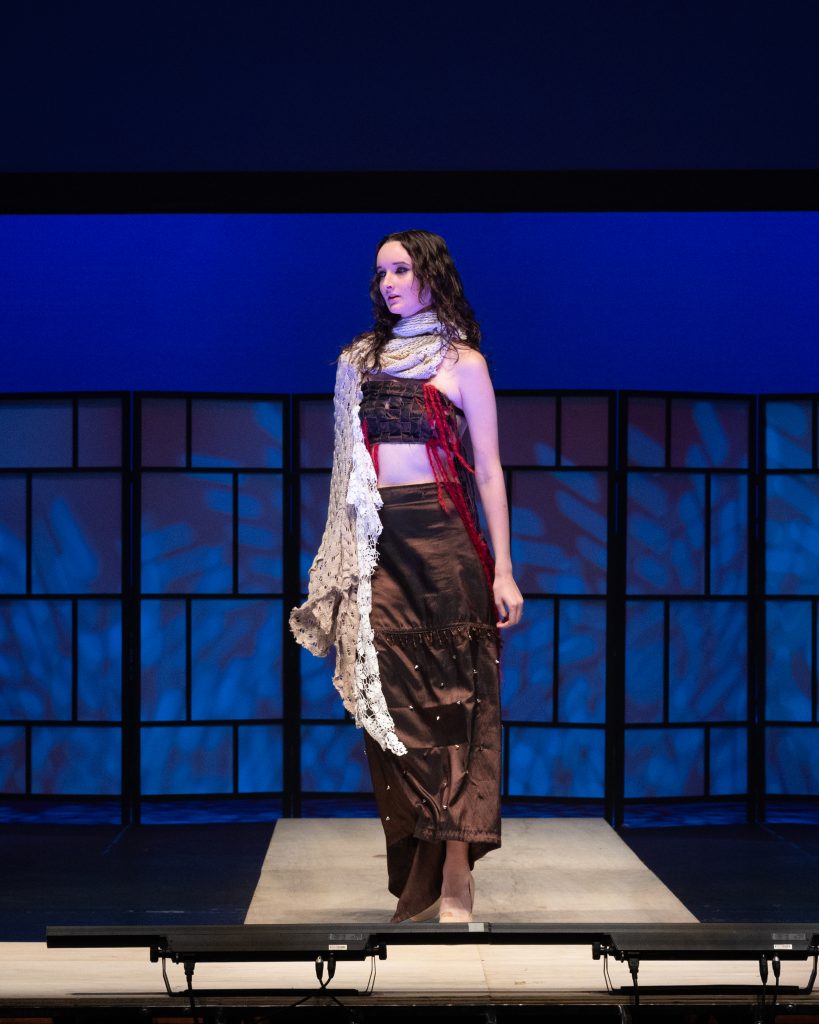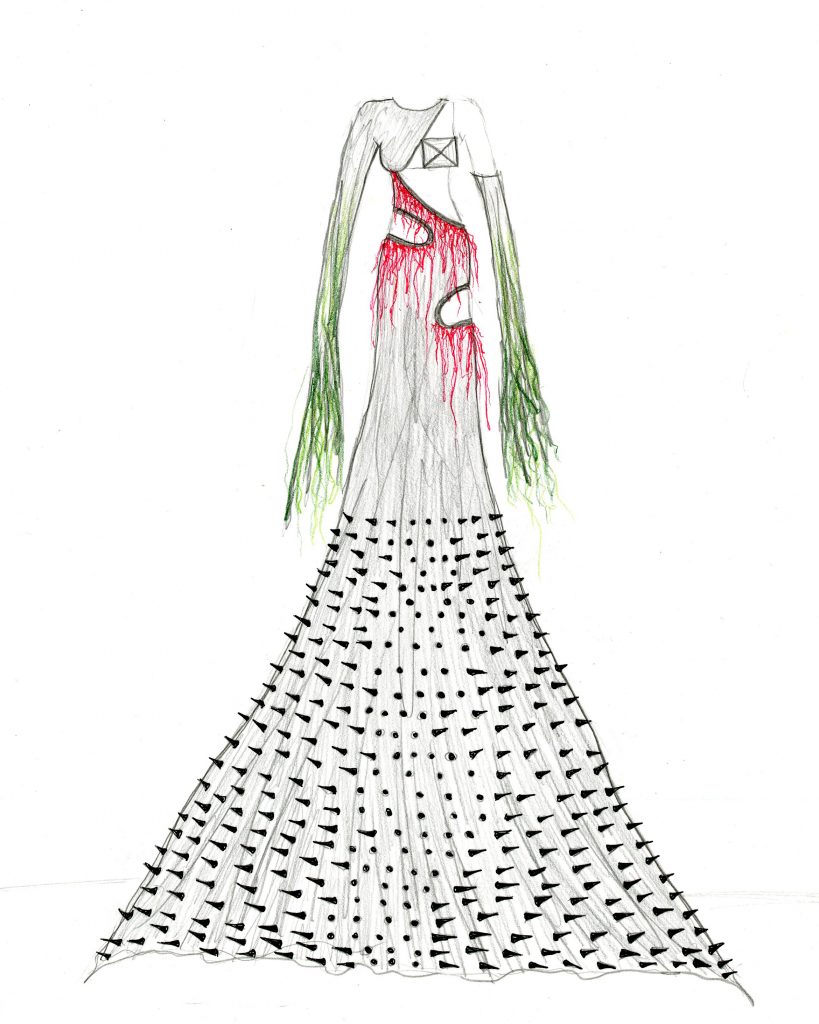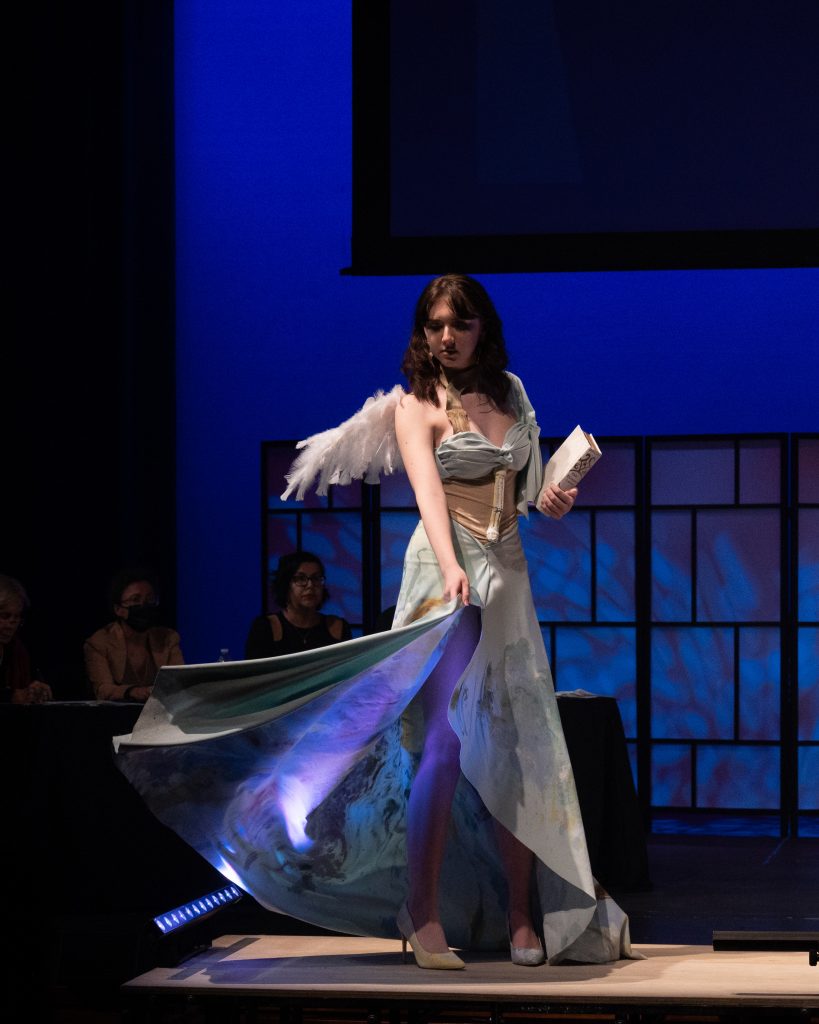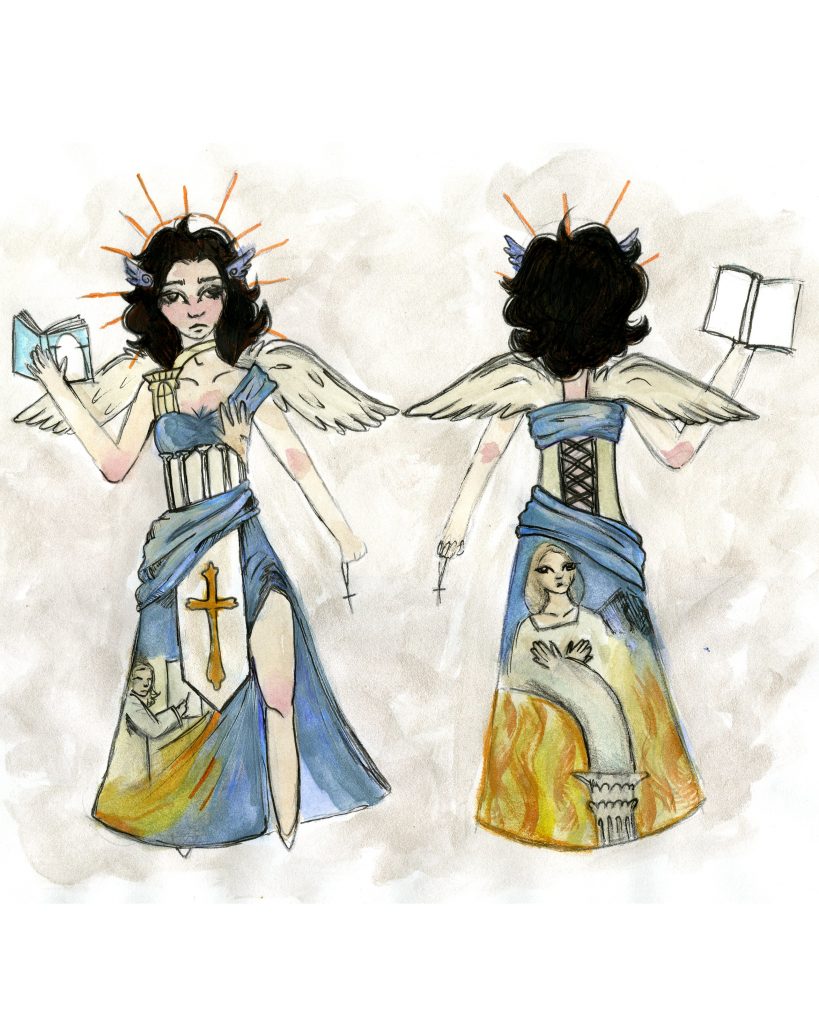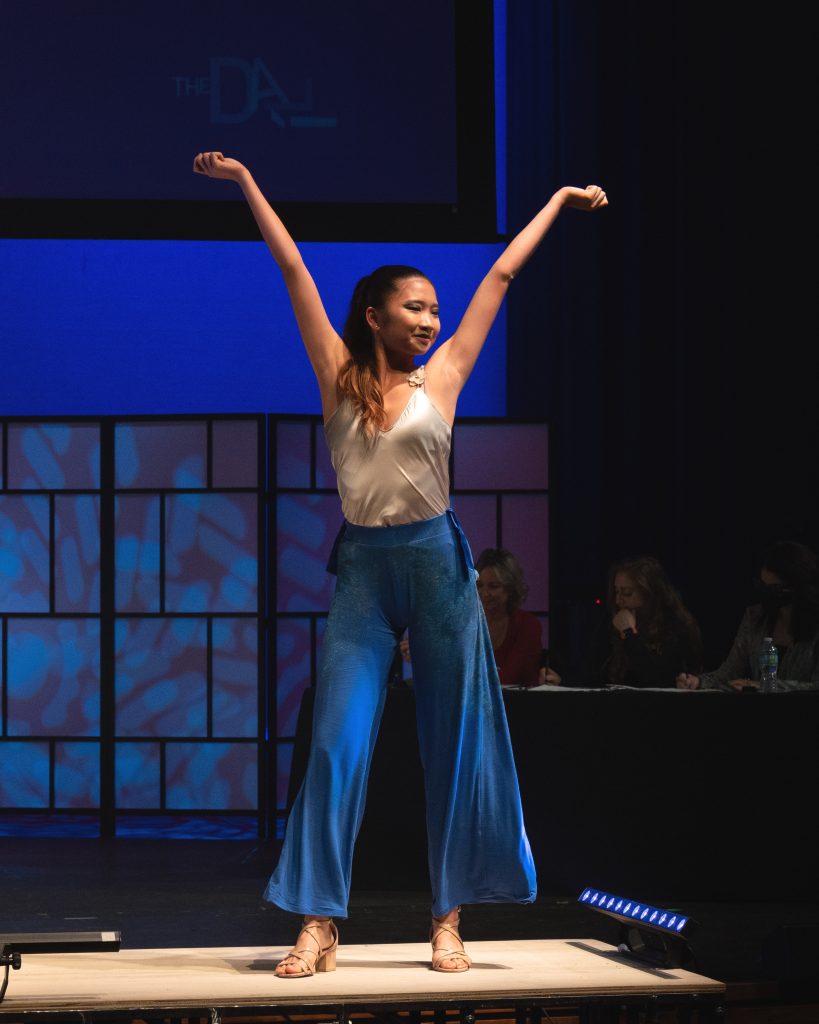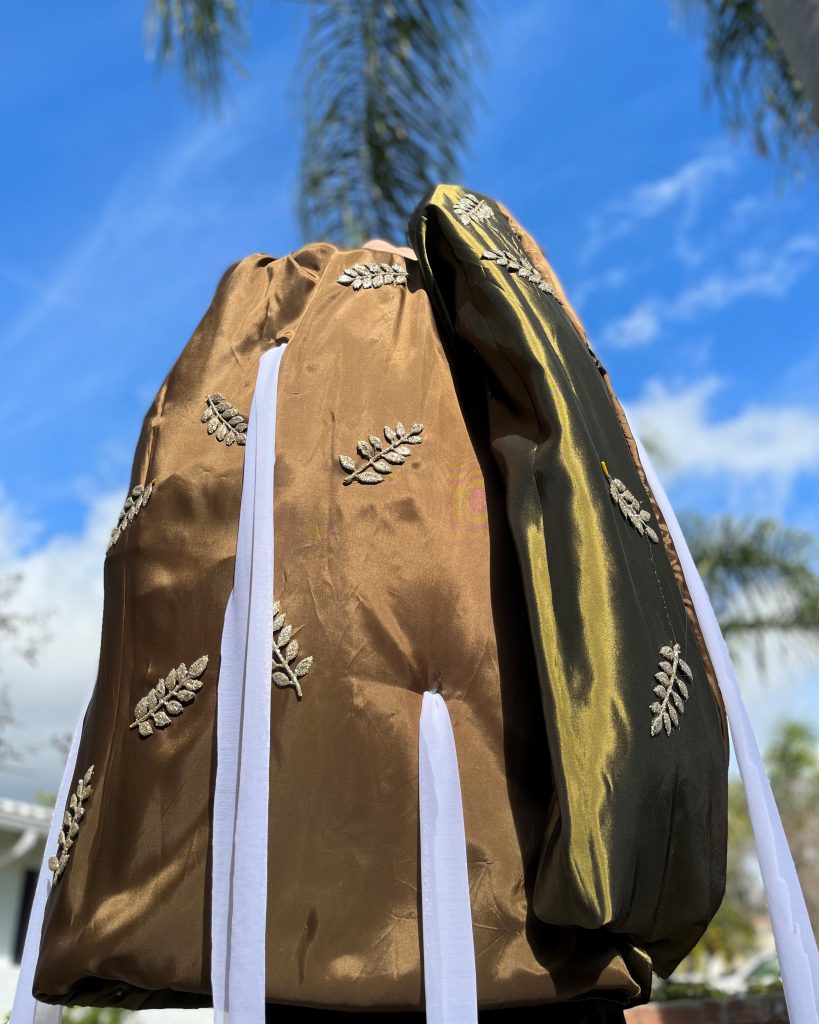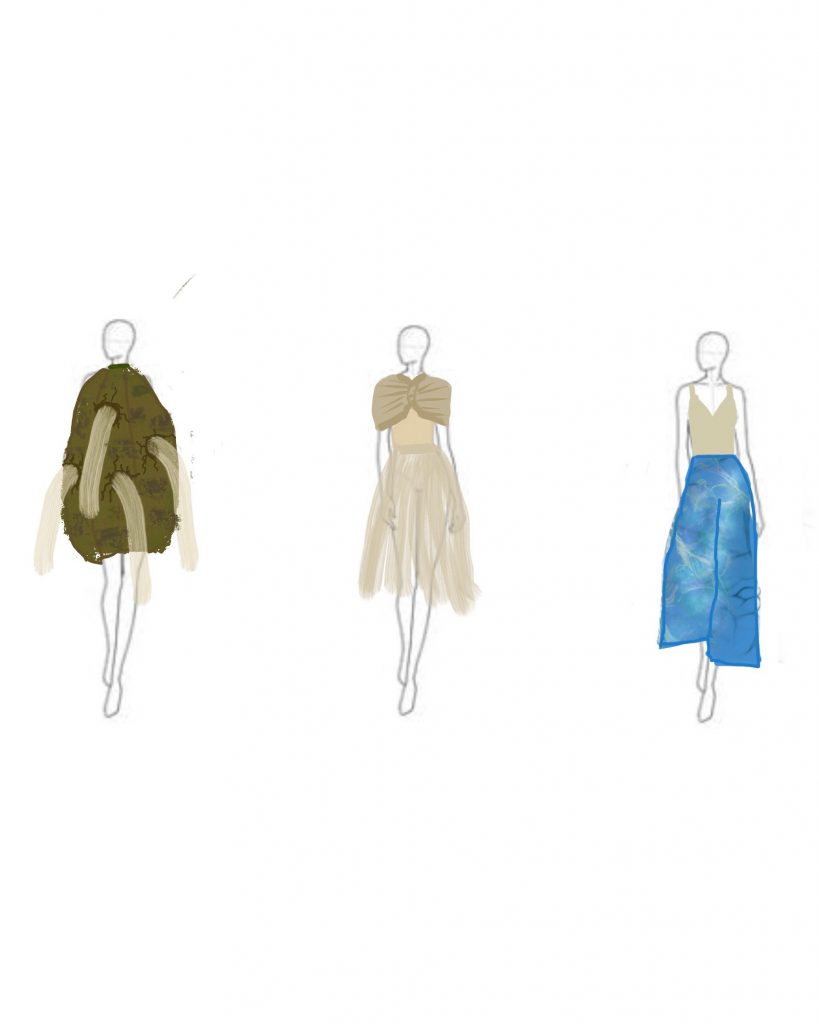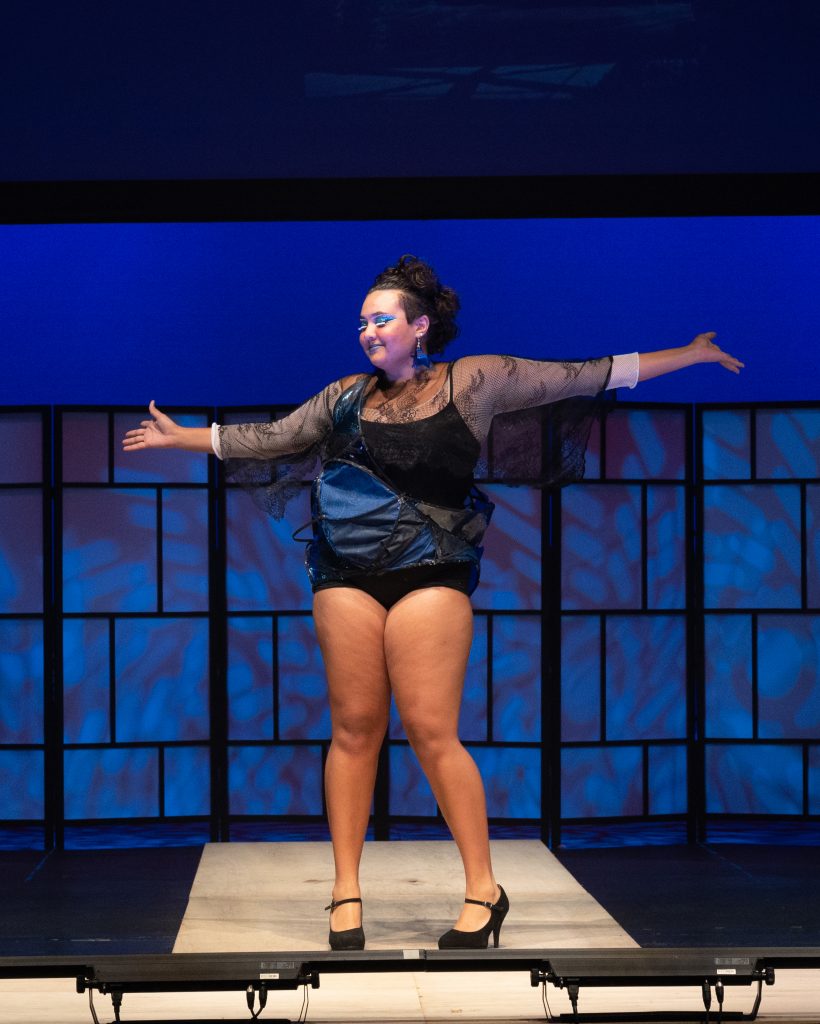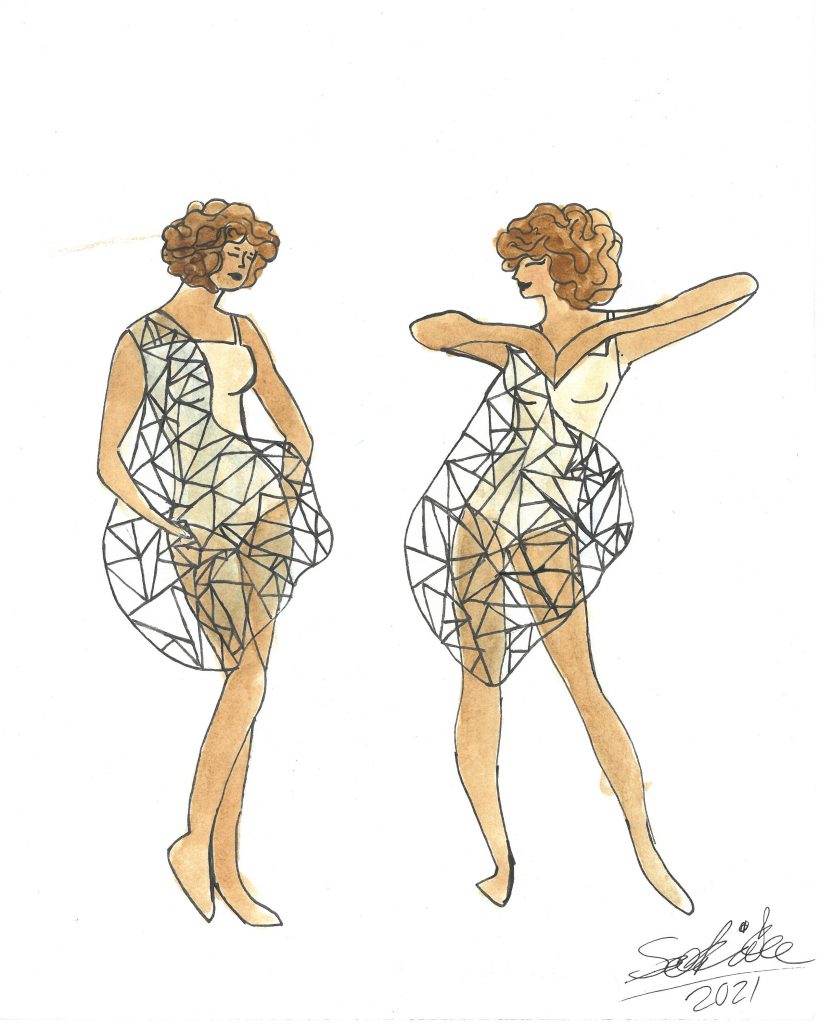Dalinian Architecture
In 2021, twenty-seven budding young fashion designers from high schools across the Tampa Bay area completed the thirteen week program, Fashion Design at The Dalí. Participants learned the fundamentals of design and construction techniques, explored the use of non-traditional materials and learned runway presentation from experienced artists and designers. The students (9th – 12th grade) explored the connections between art and fashion, creating runway ready wearable art inspired by the work of surrealist Salvador Dalí. This year’s theme focuses on Dalinian Architecture.
Abbie Garretson
Back View of Enigma
Grade: 12
Gibbs High School – PCCA
My inspiration was the entirety of The Dalí Museum’s exterior architecture. The St. Petersburg Dalí Museum opened on January 11, 2011, and consists of a rectangular concrete base with a reimagined geodesic dome made of insulated with argon glass. The entire structure represents rational thought vs fantastical nature through the use of organic, formulaic and stagnant structures. This is the theme I took for my piece. My tri-layered design consisted of a mesh bodysuit with sewed-on rectangular embellishments, an angled ash-grey pencil skirt and tube top, and a free-formed/ abstract blue dress with painted details and ruffled bottom. The top layer of my dress was an original pattern that I hand-drafted and scaled to fit my body in hopes of mimicking the mathematical process that went into calculating the dimensions and design of the Enigma (the glass structure). Its use of color and form is intended to mimic the Enigma both visually and in its organic nature. The gray pencil skirt takes inspiration from the concrete structure by being a contrast to the dress’s ornamentation and revealing design. Finally, the bodysuit and embellishments serve to reference the segmented quality of the Museum’s pavement. My goal for this dress was to represent The Dalí Museum’s exterior architecture both visually and thematically.
Alexander Rangelov
Broken Bridge
Grade: 12
Plant High School High
Angelique Morgan
Disintegration of the Persistence…
Grade: 12
Northeast High School
When designing my garment, in the beginning I tried to make it as close to the piece I chose as possible. As I worked on it more I decided to tone it down and pay a more subtle homage to the painting. The painting I was inspired by to make my garment is The Disintegration of the Persistence of Memory, 1952-54. I was inspired by this painting because of how complex it was, and how each and every element came together to play a part in the painting. I tried my best to use elements such as pieces of clocks and buttons to mimic the melting clocks shown in the painting. The process of picking my painting and creating an inspired look helped me grow as a designer, by helping me learn what goes into a design and how much hard work and the persistence it takes. I believe that my garment will probably do a sufficient enough presentation of what The Disintegration of the Persistence of Memory, 1952-54, actually is.
Annie Miller
Morphologia Echo
Grade: 12
Gibbs High School – PCCA
Billie Marani
Terpischore
Grade: 11
Palm Harbor University
My design for The Dalí Architecture Fashion show was inspired by a statue Dalí casted with bronze called Terpsichore,1971. Loui Fuller was an American dancer who gave me inspiration for my design. Loui used long flowing capes and sleeves in her dances waving them around while she danced. I wanted to incorporate that kind of movement into my design with flowing ruffles going up and down the arms of my black long sleeve turtle neck along with a pair of black flowing pants with the same ruffles. Finding fabrics that would mimic the aged color of the bronze was challenging but I ended up finding this sort of turquoise/ gold granite fabric for the ruffles and possibly a cape that would pop against the black fabric. Another element I wanted to add to my design was the triangular reflective windows seen in the background of the sculpture, to do this I cut up old CDs into triangles and placed them onto the turtle neck in an intricate pattern. This was a completely new experience for me and one I normally wouldn’t see myself doing because of my lack of knowledge to this material but I wanted to put myself out there and really challenge myself for the first time using this material and to experiment with new ideas I come up with along the way. I’m very lucky to have had this opportunity to learn from my peers who have more experience than I do.
Bola Gerges
Venus
Grade: 12
Palm Harbor University
The design of my piece depicts the oppositions portrayed in Salvador Dalí’s Venus de Milo with Drawers(and PomPoms), 1964. Dalí introduces an impression of sensuality, which is often demonstrated in women, through the locations of where the drawers are placed onto the Venus statue. He conveys an erotic imagery of pompoms which are placed on the drawers to mimic the knobs. In my piece, this will be transformed into a top with individually placed cotton balls to imitate the texture and intimate perception sensed when with a woman. The draped fabric which sits on the statue’s legs is objectified in my garment by constructing flair pants that flow gently on the leg while walking. In order to illuminate the same seductive energy of a woman that Dalí exemplified within his architecture of the drawers, my composition includes pockets which are sewn onto the pants – both are objects which allow for further exploration of its interior. Additionally, maroon pants and gloves add to the intense and passionate objectification of women within our society.
Britney Meza
Disappearing Bust of Voltaire
Grade: 11
Boca Ciega
Salvador Dalí’s work, Disappearing Bust of Voltaire, 1941 has very important dress wear that I have decided to incorporate in my piece. For example, I will make the neckline of a noble, adding ruffles to the neck (very important in portraits of noble and upper society). Considering a very essential piece of culture in Spain, I will draw attention to the traditional dress wear in Flamenco to form a skirt reminiscent of the colors and style known to Spain. The materials used for most of my outfit will be curtains, and old clothes from the back of my closet. Since the painting depicts a slave market, the under shirt of the outfit will be very similar to the one in the painting of the slaves. The arches reminded me of a headband and the object in the red cloth material looks a like beret so perhaps I will include both for headwear. This project is an attempt to modernize the historical and architectural aspect of Dalí’s painting, and understand Dalí’s cosmogony.
Connor Totten
Geopoloticus Child
Grade: 11
Gibbs High School – PCCA
Eden Mateo
Interior view up
Grade: 12
Gibbs High School – PCCA
My design is inspired by the spiral staircase and the glass Enigma of The Dalí Museum. The helical shape of the staircase speaks to Dalí’s fascination with DNA; he often portrayed the spiral form as the basis of life in many of his works. Similarly, the Enigma is geometrically structured, composed of triangular pieces of glass, but ultimately creates an organic form surrounding the building. These are the main ideas I based my design upon. In my piece, I also wanted to showcase the contrast between the smooth and shiny Enigma against the exposed concrete walls of the museum. I will do this by soldering together a glass corset, and experimenting with dipping pieces of the fabric skirt in concrete. To mimic the structure of the staircase and DNA, I chose to break down the helix shape into 6 curved ribs that surround the midsection of the dress, made out of the concrete dipped fabric.
My materials are all thrifted or found. For example, I am using beach glass I found on a beach in Michigan to create the corset top, and thrifted bedsheets as fabric for the skirt. One of the construction processes I am using to create the corset is soldering. This process includes melting metal wire with a soldering iron to weld together the pieces of glass. This results in a piece similar to a stained glass window, which I will build around the shape of my body to fit like a corset.
This process of design and construction helped me grow as a designer by allowing me to think outside of the box with my choice of material, and showing me that fashion doesn’t only have to be sewn with fabric. Instead, I realized I can create wearable pieces that fit the theme of architecture with materials like glass, wire, and concrete.
Elizabeth (Libby) Lewis
View of Port Dogue
Grade: 9
Plant High School High
Dalí’s use of purple in the painting View of Portdogué (Port Alguer), Cadaqués, 1918 popped out at me when I first saw his work. I took this element and made my work abstract, flowing from the waist down. The brush strokes of his painting create the illusion of moving water, which I hope to achieve through the fabric choice of chiffon in my piece. While trying to make sure that everything was lined up perfectly and would run smoothly, I learned that you have to accept change throughout the process. Being able to do this has allowed me to adjust my outfit such as the color choice, shape of the top, and little details that will add to the overall effect to create the final piece. Along the way, I’ve discovered how architecture and artwork come together to create exciting new designs that bring inspiration and excitement into the world.
Isabella Vitale
Enigma view from Overlook
Calvin Husinger School
Grade: 12
My design is very geometric. It is based off of the triangular windows that comprise the majority of The Dalí Museum in St. Petersburg, Florida. The second I saw a picture that included the windows as one of the options, I knew I would re-create them with holographic fabric. I knew placing the holographic fabric on the skirt would take time, rather than start from scratch and create my own skirt from a pattern, I used an old witch costume as the base of my dress, transforming it into an avant-garde gown. Each triangular window is unique and hand cut by me, representing the diversity of the human experience that art often conveys. At first, I velcroed them on, but they wouldn’t stay so I had to re-adhere them with E6000 Adhesive. For the bodice, I chose a geometric mesh and velvet top that I found while I was thrifting.
Isolde Rayman-Moore
Nature Morte Vivante
Grade: 10
Hillsborough High School
I was inspired by the architecture inside Salvador Dalí’s Nature Morte Vivante (Still Life— Fast Moving), 1956. I used the red tablecloth as inspiration for the top, the red pattern over the black being based on the red table cloth with the four-pointed stars pattern popping against the black wall. I used the water as inspiration for the belt line that goes around the back, the circular way the water is pictured is represented in the circular belt gems. For the skirt, I was inspired by the DNA helix type shape in the post of the balcony gate. I used the gold color and twisty shape to design the ruched skirt pattern. I made the top by sewing red lace over a corset, and the skirt with gold fabric pulled together by Austrian Drape Tape. I drew a lot from my painting, which made it a little more challenging to do all the different elements, but it was very fun to do, and I feel it represents the main elements of my artwork well.
Kate Schmitter
Toreador
Grade: 9
Plant High School
Salvador Dalí’s work is, in a word, surreal. I wanted my garment to convey the same dreamlike fantasy that his art evokes. My gown is inspired by the The Hallucinogenic Toreador, 1969-70, an illustrious work of his. The piece showcases the Venus de Milo, a statue of Aphrodite in the notable contrapposto pose. Accompanying her are soft blooming roses in light pink hues. To capture the essence of the piece, I set out to create a long flowy dress with roses blooming out from the fabric. My main objective was to convey serenity, femininity and romance. Regarding accessories, I made use of roses in various forms such as jewelry, hairpieces, and accents on the Mary Janes. In order to properly address the dark undertones Dalí intended, I paired the soft, delicate rose-oriented garment with harsh, grunge, knotted nylon gloves and black platform Mary Janes. In addition to the gloves and platforms, the makeup is dark as well. The makeup look is light and glowy, finalized with a pitch-black smokey eye. The idea of creating a garment was less daunting than it originally sounded. While fashioning a garment is an intricate and detail-oriented process, it was nowhere near as jarring as I thought. I gained a lot of experience, knowledge, and passion that I’ll apply to future endeavors. This process helped me immensely in growing as a designer and opened my eyes to a new world of opportunities. A goal of mine for the future would be to become comfortable with a sewing machine.
Kendall Swartz
Spiral Staircase
Grade 12
Gibbs High School – PCCA
Architecture isn’t just the construction of buildings or what is contained in the building. It is the design of a building or object. The one common question that is asked when building a staircase is “what is the staircase’s primary purpose?”. Salvador Dalí’s Helical Staircase’s primary purpose is to give access to the many visitors that visit the museum in a day to see Dalí’s paintings. The staircase in the museum is what holds the painting up and gives access to patrons.
In my design, I am representing The Dalí’s Helical Staircase. I am presenting the staircase physically and metaphorically in my construction. When looking at the staircase at the museum, one thing that stood out to me was the concrete holding the staircase together. That is the part of the staircase I am physically representing. In my design, I am going to make the staircase spin around my model’s body representing the staircase always being in use. I’m going to attach a lazy susan to her head to make the spinning mechanism. Then, to make the staircase I’m using a spiral metal Christmas tree as the base then covering it in fosshape. Then, I will create a cover to go over the fosshape. The cover is going to be made out of fabrics I found from the thrift store. They are going to represent the paintings at The Dalí. Since the staircase holds up the paintings at the museum that is what I want to represent with the cover of the staircase. Then, I will be using hangers (That I spray painted navy blue—since navy blue represents stability) and shrink wrap to fill in the empty space to make the staircase.
Underneath the staircase, I am making a bodysuit out of sculpting coat and muslin. I am going to include the architect Antoni Gaudí. Dalí was very inspired by him throughout his work. I am going to involve the spirals that Gaudi uses in his work in my bodysuit. And I will continue to use the spirals on the legs. I will represent that through painting on the leggings with silver paint. I will also spray paint the bodysuit silver in my design.
Kiera Richardson
Living Wall
Grade 10
Blake High School
The design of my garment is inspired by the Cheezem family reflection pond, outside of The Dalí Museum. I wanted to make sure that I included most of the pieces of the pond in my piece. The pond has many different colors and textures. I incorporated the variations of leaves and plants on the top. I wanted to make sure all of the different elements shown are dynamic. Therefore, I decided to make my garment a two piece instead of a dress. When I saw the pond, it had the beautiful separation of the flowers and leaves from the rocks and the water; that’s another reason why I did a two piece. My goal is to have a lot of leaves on the top of the shirt to represent the big variation of the garden portion of the pond, and then have it slowly fade out as it goes down to the skirt. I incorporated a skirt with a thigh slit to give the outfit a more fashionable attire. With the thigh slit skirt, I wanted it to drape down to the floor to demonstrate the water of the reflection pond and to have the rocks to be on the side seam. The rocks will be gathered fabric and be put into a shape of a rock and then hand sew down onto the skirt. The rocks are placed almost the same as the Cheezem family reflection pond, therefore the rocks are almost placed around the skirt.
Kiersten Reaume
Infanta Margarita
Grade: 11
Gibbs High School – PCCA
Layla Marani
Cadaques
Grade: 11
Palm Harbor Universe
The artwork I selected was Cadaqués, 1923. It was taken from the view off of a rock terrace above Salvador Dalí’s home. I chose this lace to embody the refreshing costal winds of Costa Brava. I chose the romper/jumpsuit because when I think of fun in fashion, my mind always goes to a fun and funky jumpsuit. Dalí came to the coastal town with his family on retreats often, which is why I wanted to add an element of fun and more relaxed vibes that you wouldn’t get from a gown. The over skirt and plant details were to portray the costal tree leaves as seen in the painting. Hair pieces are colored like the pretty hot-air balloon and the hair style comes from the braids seen as each girl has in the painting.
Mckenzie Mallory
Galacidalicid…
Grade: 10
Blake High School
Salvador Dalí was an extraordinary artist known for his Nuclear Mysticism in his paintings. In his painting Galacidalacidesoxiribunucleicacid (Homage to Crick and Watson), 1963. Dalí used a mixture of everything from DNA, a cloud with God carrying Jesus Christ, angles, and human cubicles. For my design I want people to experience a walking version of the painting itself, as if the painting was to become alive. When you look at the painting Galacidalacidesoxiribunucleicacid (Homage to Crick and Watson), 1963 the first thing that you see are the clouds. In my design, I wanted the first thing that grabs your eye to be something that resembles a cloud. For that I decided to use Tull to resemble the cloud’s fluffiness. I wanted it to be of a considerable size and stand out; in order to achieve this, I have the Tull wrapped around the jumpsuit like a sash. In the cloud it also has different colors, so I have multiple colors of Tull. On the clouds there is also an angle that I wanted to include so I used wire to form two wings and sewed white fabric over them and placed them near the cloud just like the painting. On the left of the painting there are humans forming cubicles. When I first saw the human cubicles, I knew that somehow, I had to add a version of them to my design. Therefore, I made a head piece, to incorporate the human cubicle. To make the head piece I used action figures on the side and for the base and the top of the cubicles there are wooden sticks. For the jumpsuit I wanted it to have the same effect as Galacidalacidesoxiribunucleicacid (Homage to Crick and Watson), 1963 so I painted it using the same colors Dalí used, such as black, tan, and grey, and spread it all over the jumpsuit smoothly just like the painting. Lastly, I wanted to feature the DNA, so I painted over Styrofoam balls and made them an arm piece. I just want to say that the Dalí program has really helped me grow as a designer by showing me that fashion can be any way you make it, and not just a simple piece of clothing, it’s a statement, thank you.
Mikaela Parrish
Interior Enigma View
Grade: 11
East Lake High
My garment is inspired by the Enigma window at The Dalí Museum. Though Dalí himself didn’t make it, the Enigma was modeled after one of Dalí’s own atop his other museum in Spain. In my garment, I wanted to capture the window inside out. The hoop skirt is supposed to symbolize the window itself, so I created triangles using extra ribbons, Many of which are different shapes and sizes to emphasize how in the Enigma every glass triangle is a unique shape. On top of the hoop skirt is a layered skirt; I used many shades of blues and purples to symbolize the water from the docks right outside the window. Another element in my piece is the sleeves that are slightly reminiscent of armor. I wanted to add more elements with the design of the window while also implementing its shape. Thus, I used aluminum wire and string to make sleeves in the shape of a helix, one of Dalí’s favorite shapes. Overall, I want the piece to look as though if you stood within the hoop skirt, you would see exactly what you would from within the Museum. This year’s theme of Dalínian architecture provides thoughts of strength and structure in his artwork. Through the sleeves and hoop skirt, I was able to accomplish that perfectly, and the flowingness of the half skirt juxtaposes that beautifully. Through my design, I was able to capture Dalí and his surrealistic ideals.
Noïal Randelli
Archeological Reminisence
Grade: 12
Homeschool
The ensemble I have designed was inspired by Dalí’s painting, Archeological Reminiscence of Millet’s Angelus,1934. It has a tower in the form of a woman on the right that is taller, dominant and powerful. She poses a threat to the male figure on the left. Dalí imagined the woman as a praying mantis, considering that the female mantis poses a sexual threat to the male in their species. I have incorporated this into my design by creating a headpiece, resembling the head of a praying mantis as well as making a wing-like cape. Both of these pieces acknowledge the authority of the woman as they are considered items of royalty. Throughout my process, I have incorporated the color palette that Dalí used in his painting-from dark and light blues to earthy tones of gray, brown, and bright clay-like orange. I made the waistcoat out of cloth that references the color and look of the monoliths in Catalonia. They were the inspiration for the figure towers in Dalí’s painting. I also wanted the vest to be a reference to Millet’s L’Angelus, because in the 1850’s it was common for men to wear waistcoats, and I feel that putting this item of clothing on the female figure expresses a switch in stereotypical gender/power roles. I combined this with a skirt that conveys feminine energy with a v-shaped waistline and sheer blue layered cloth. I created this piece with the intention to evoke a sense of feminine divinity and ascendancy.
Penelope Ubau
Weaning of Furniture – Nutrition
Grade: 11
Blake High School
My design is an open back, draped, structural dress that contains a choker with spinal cord piece that are made out of metal. Then, it will have hands pulling at the dress constructed from stuffed rubber gloves. The structure that will hold up all the sides of the dress will be devised from wire like a hoop skirt. The bottom of the dress will be lined with hooping to make sure that there is organic flow at the bottom of the dress. My piece was inspired by Salvador Dalí’s artwork The Weaning of Furniture-Nutrition, 1934. Specifically, the way he has mourned a person who has influenced his life. He drapes her face with a white cloth in the picture, this is one of the only light parts of the piece that is completely white. He shows his original home in Port Lligat. My design reflects transformation, the front side is elegant which shows remembering the side of you that is not always seen on the outside. Then, the back is brought to life as it shows chaos and deception. I’m making a social statement about losing support in addition to chaos of death even if the water is still. I have never made a dress or anything that has been worn before. My work is basically the tailoring clothing. This is my first real project, and I am very excited but very nervous to be working and creating an original object that I have designed by myself. I have overcome the challenge of my brain because throughout this project I have felt that I was not good enough or that I could not do this because I’m so new to making something on my own. However, I have overcome this by telling myself that this is an experience. The Fashion Design at The Dalí program shows me that I am and can do something amazing. I learned from this experience. Another problem that I overcame, is that I did not know how to even start this project. With the help of my costume teacher at my school and the PCCA Gibbs High School costume teacher, I began to start my own project. For that, I owe them so much gratitude. As a designer, I want to make designs that are art but unconventional and made for anybody, to show that you can be who you are with no restraints.
Rajan Singh
Bali Eggs on a Plate
Grade: 12
Florida Virtual School
My idea and vision starts with the inspiration from Salvador Dalí’s Oeufs sur le Plat sans le Plat, 1932. I wanted to create something simple, wearable, statement worthy, and something with a deeper meaning than only the painting. I was also inspired by my own imagination. Having favorite designers and creators help me with the “behind the scenes” of fashion design. I can understand how they work (and not just what they make) and what it takes to create something with meaning. I’m aiming to make both a social and personal statement with my entire outfit. I feel like I should like what I made, and also like how I got to my final product. It’s about the hard work and idea behind it. On the other hand, I would also want others who appreciate fashion to understand what my vision was. I’m creating a “Dalí oeufs info” safety orange hoodie, with black pants, flared with black material to create “eggs flowing”, and for the shoes, I will be wearing off white, Jordan 1’s that have some hints of safety orange. The vision behind the “Dalí oeufs info” is to create a black text on the hoodie of the information about the painting. The artist name, painting location, and date created. The orange colour will represent the vibe of the art. This process and opportunity allowed me to create something in which I envisioned, wanted to put on paper, and then make into fashion.
Savannah Nasworthy
Still Life – Sandia
Grade: 12
Gibbs High School – PCCA
I am a plus size woman, and I have been most of my life. The second I got accepted for this show I knew I had to make a piece for plus size women. We rarely ever get to dress in the out of the box fashions that thin people parade around every fashion week. I also wanted to do this on a budget. I don’t have the money to buy a 300 dollar sparkly gown, so why would the piece I make be costly too? I am using materials from the thrift store, Dollar Tree and anything I can find really! I am mainly inspired by Rupaul’s Drag Race! The campy fashion that the show is built on is what I love most. The Salvador Dalí piece my dress is inspired by is his still life, Still Life: Sandía, 1924. I love the geometric feel and the bright colors. My design has quickly grown to include more fruity imagery. Especially the watermelon! Since “sandía” translates directly to watermelon. The painting seems quite gothic and intense to me. I wanted my dress to display this intensity all at once. That’s how I feel when I look at anything Dalí creates. Everything all at once. That’s how I feel being a plus size woman. That’s how the drag queens walk through life. I am colors; I am shapes; I am space; I am everything all at once. That is what this piece is. Everything.
Simona Tamulevicius
Tristen Foe
Grade: 11
Gibbs High School – PCCA
Skylar Parker
Ecumenical Council
Grade: 11
Gibbs High School – PCCA
I would describe my design as an ethereal or heavenly feeling, I wanted to get the feel of the The Ecumenical Council, 1960 very grand and dreamy. I plan to use excess fabric that I will dye, collaging, painting, embroidery, repurposing a book and other found objects. Such as a pair of damaged shoes or foam that is generally used for flower arrangement. I decided to paint most of the dress because my roots are in visual arts. Painting has always been my medium of choice and without it I wouldn’t have discovered different outlets of art like fashion design. So with my designs, I want to always have a piece of my identity as a visual artist. This process helped me grow as a designer by experimenting and trying new things that sometimes didn’t work. Like, the way I tried to use clay and it cracking. In my original design, the blue for the skirt was different, but the way it dyed I couldn’t help so it took a minute. It didn’t feel like a big deal, most of the other changes are just slight changes.
My dress uses elements of The Ecumenical Council, 1960 with the color scheme and imagery. The imagery includes recreation of elements from the painting itself, like the three figures Father, Son, Holy Spirt, his wife Gala and the Cadaqués rocks from his home in Spain, as well as images of crosses and heaven to represent Dalí’s faith. My favorite imagery that I included was my own self-portrait, in The Ecumenical Council, 1960, the bottom left corner you can see Dalí painting with a blank canvas looking at the viewer. Dalí was inspired by Diego Velázquez who painted himself in his own painting Las Meninas, 1656. I wanted to continue the chain of self-portraits so I decided to paint myself onto the dress as well. The elements in my dress that represent architecture is the asymmetry, use of arches, and columns representing structure working as the boning of the corset.
Sofia Pickford
Three Ages
Grade: 11
Alonso High School and Homeschool
Sofia Severino Leth
Enigma – night view
Grade: 11
Gibbs High School – PCCA
My work explores and references the architecture of the The Dalí Museum. With the influence of the architect Yann Weymouth, my piece depicts their complex design for the building in a very similar way. When designing my dress, I made it my goal to capture the organic shape of the enigma. To accomplish this, I used black boning to create the shape by cutting individual pieces then sewing them to create the triangles. After finishing the outline of the dress, I added blue lighting gels to create the look of glass panels. The Dalí Museum also challenges it’s organic structures with the simplistic look of a large concrete block. I felt it allowed the glass of the Enigma to be the main focal point of the building. I mimicked this juxtaposition in my dress by a having a bare canvas underneath. Ever since I signed up for this opportunity, I have been exploring ways I could create a piece inspired by The Dalí Museum’s architecture. The history behind the Museum is very fascinating to me and I believe the building is very fitting for Salvador Dalí. The Enigma is immensely inspired by the dome on the Dalí Theatre-Museum in Spain. It was created by a personally entrusted architect Emilio Pérez Piñero. Dalí’s bizarre style inspired the astonishing creation of The Dalí Museum and is a great inspiration for my piece.
